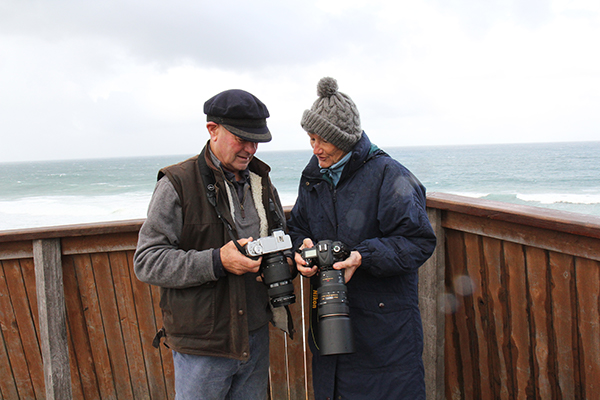Southern Right Whale research and monitoring project
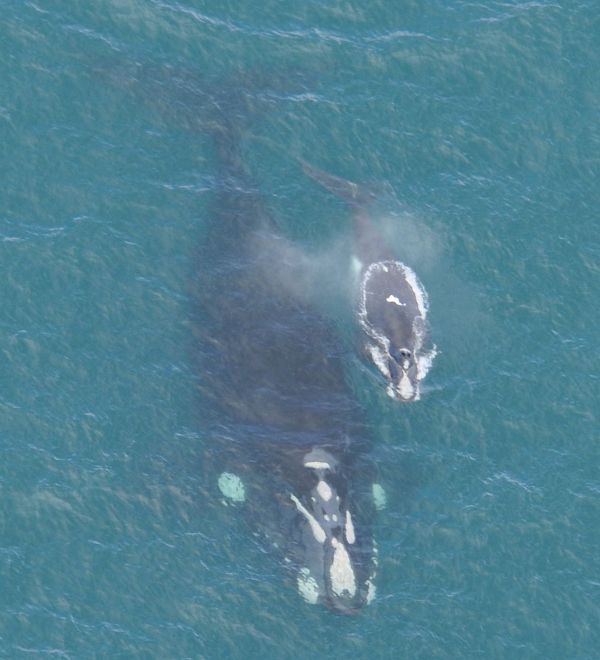
Southern Right Whale and calf. Image: Mandy Watson
The Southern Right Whale is Australia’s only inshore large whale species and was almost hunted to extinction. The south-eastern Australian population remains very low (250 -300 animals). This project is fundamental to gaining an understanding of the species ecology and population trends in south-eastern Australia.
Project activities
- Genetic Research
- Photo Identification
- DEECA sightings database
- Aerial Surveys
- Remotely Piloted Aircraft Systems (RPAS)
- Calf survival recruitment and movement study
- Citizen Science
- Project support
Southern Right Whale records in Victoria
- 2011 to 2014 whale sightings
- 2015 whale sightings
- 2016 whale sightings
- 2017 whale sightings
- 2018 whale sightings
- 2019 whale sightings
- 2020 whale sightings
- 2021 whale sightings
- 2022 whale sightings
- 2023 whale sightings
- 2024 whale sightings
- 2025 whale sightings
Southern Right Whale species profile
News and feature items
New technical report
Small but growing- community sightings strengthen researcher findings.
- Calving intervals, long-range movements and site fidelity of southern right whales (Eubalaena australis) in southeastern Australia
- Population estimate and rate of increase of southern right whales Eubalaena australis in southeastern Australia
Genetic Research
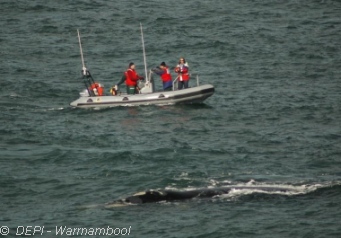 |
| Taking biopsy samples under strict conditions to determine genetic differentiation. |
There is now evidence of significant differentiation between South Africa, South America, Australia (WA) and New Zealand haplotype and nucleotype levels (Patenaude et al. 2007). Further genetic work between 2001 – 2009 involved data collection from South Eastern Australia which was coordinated by DEPI with support of state and commonwealth funding (AMMC).
Analysis of mitochondrial DNA from 56 samples from New Zealand, Western Australia, South Australia, Victoria and New South Wales found:
- Levels of genetic diversity in the South East Australian population was high and comparable with South West Australia
- There are significant difference in mt DNA between South East and South West Australia and New Zealand
- The amount of differentiation between the two Australian populations is greater than either compared with New Zealand
(Carroll et al. 2011)
In 2014, further work was carried out with an expanded sample size (94 whales) which also included Tasmania. Preliminary results indicate a confirmed significant mt DNA differentiation between South East and South West populations and differences between states detected using microsat data which is being investigated further.
There is a mixing of whales from genetically distinct populations on the migratory corridors (Watson et al. 2021).
Photo Identification
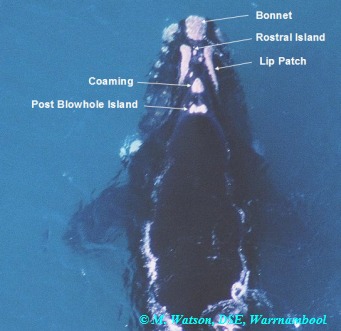 |
| Features used in photo identification, based on terms used by (Bannister 1990). |
Each Southern Right Whale has its own unique pattern of white markings (callosities) covering the head area which is used for photo identification (see diagram, based on Bannister 1990). There are four major identification catalogues in Australasia, (South-east Australia, Head of Great Australian Bight, Western Australia and New Zealand). Workshops are held every two to three years at which time photos are matched to assess population size, structure and movement.
The South-eastern Southern Right Whale photo-identification catalogue was established in 2002. It is a multi-government agency project which is co-ordinated by DEECA, Warrnambool. The project is supported by Commonwealth and State based threatened species funding.
Whale identification flights are conducted opportunistically from South Australia, Victoria, Tasmania, New South Wales. Images are stored in Southeast Australia Southern Right Whale Photo Identification Catalogue (SEA SRW PIC). The project also uses the BigFish© system developed for the South Australian government. It is an Access Database with photo-ID matching facility (CodeCompare) based on a system designed in USA. The catalogue holds over 3000 images - primarily dorsal view comprising identification of 450 individual whales.
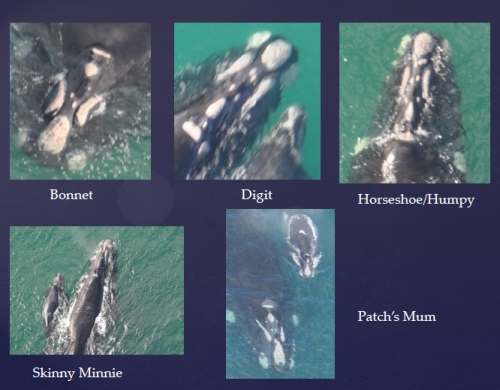
| Examples of individual whales which have been identified by matching the unique pattern of white markings (callosities) covering the head area over repeated seasons. Source: SEA SRW PIC Catalogue - Warrnambool. |
Key findings from photo identification data
Source: (Watson et al. 2021)
- Between 1993 and 2018, 375 individual whales (including 48 breeding females) were identified in south-eastern Australia (east of the SA/Victorian border).
- The mean calving interval is 3.5 years.
Movement
- 7% of whales sighted in the south-eastern Australian Region were also sighted in the south-western Australian region.
- Females belonging to one subpopulation can relocate long-term to a calving area in another region. E.g., Calving female SE9901 (‘Wilma’) had shown strong calving site fidelity to Logans Beach in south‐east Australia before shifting to the Head of Bight calving ground in south‐west Australia.
- Whales from the south-western subpopulation arriving on the Australian coast from summer feeding grounds in the south, move in a circular anti-clockwise direction into south-eastern Australia before traveling west to calving grounds in SA and WA.
Logans Beach
- Between 1995 and 2018, 51 individual whales were identified at the Logans Beach calving ground at Warrnambool, 15 of these were females accompanied by a calf
- 93 calves were born at Logans Beach between 1980 and 2018 (an average of 2.6 per year)
Photo ID results
- 2016 photo ID results
- 2017 photo ID results
- 2018 photo ID results
- 2019 photo ID results
- 2020 photo ID results
- 2022 photo ID results
- 2023 photo ID results
DEECA sightings database
Sightings of whales have been carried out by the DEECA at Warrnambool since 1985. Between 1980 to 2021, 96 calves have been born at Logans Beach, Warrnambool with an average of 2.6 per year. The most born in one year was 6 calves in 1985. Records indicate no discernible increasing trend. These results combined with the photo identification work suggests that the South-eastern population is small, isolated and therefore very vulnerable compared to other populations which have recorded a 7% increase per year.
Across Victoria, the location of whale sightings is highly variable and usually with a short residency period. The areas of highest density are Portland, Port Fairy and Warrnambool (Logans Beach), Port Campbell Peterborough.
The majority of first sightings in western Victoria1 occur in May (54%) and June (42%). The majority of last sightings in western Victoria occur in September (50%) and October (38%) but there may be an increasing trend towards October with last sightings occurring in 7 out of last 10 years in October.
The earliest sighting on record was at Portland on 22 April 2006. The latest sighting on record was also at Portland on 27 October 2010.
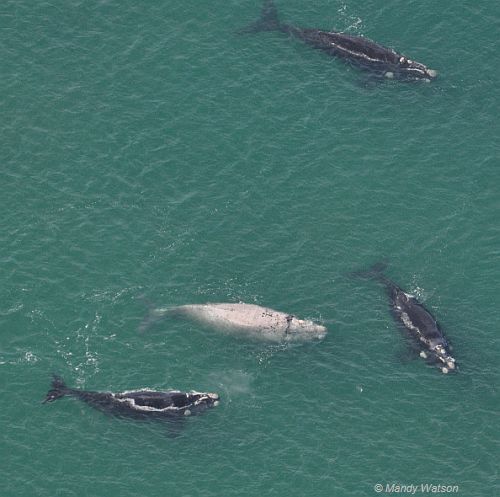
| An unusual sighting of a 'white' Southern Right Whale off Port Fairy 27 July 2011 taken by Mandy Watson, DEECA, Warrnambool as part of the Victorian Whale monitoring program. |
Cow and calf pairs (records 2001 - 2011)
Eastern
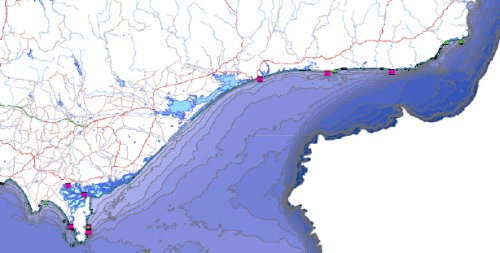
Central
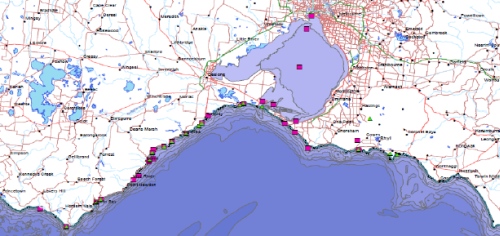
Western
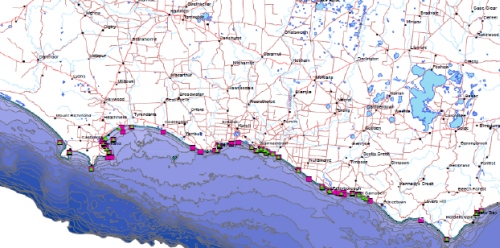
Aerial Survey
The first full population surveys of the South-east Australian region to obtain abundance estimates commenced in August 2013 and were conducted privately by Balaenidae. These surveys used the same methodology which has been used in South-west Australia since the 1970’s.
The aerial surveys involve long coastal flights conducted between Ceduna and Sydney including Tasmania over 7 days to count numbers of Southern Right Whales. A population model is based on the number of cow/calf pairs and assumes;
- each reproductive female is recorded on the coast only once in 3 years
- sex ratio of the population is 1:1
- ratio of immature to mature is 1.41:1- based on the 1998 Cape Town assessment meeting estimate (IWC, 2001)
The 2013 total population estimate was 189 (assuming same numbers of females each year for 3 years) or adjusted to 201 (assuming contiguous with WA). A 2014 survey was completed but the data has not yet been collated.
Two fixed-wing aerial surveys during the 2024 season. The first survey was on the 13/8/2024 and commenced at Nelson (on the Vic/SA border) and concluded near Gabo Island (on the Vic/NSW border). During this flight 3 cow-calf pairs close to the Fitzroy River Mouth near Portland and two unaccompanied adults near Loch Sport in Gippsland. The second flight took place on 9-10 September 2024, commencing at McLoughlin’s Beach in Gippsland and concluded near Sydney Harbour. No Southern Right Whales were observed during this survey, however a number of other baleen whales were observed on the Gippsland coast.
A minimum of 3 years survey is required to obtain a more accurate snapshot of population abundance.
Remotely Piloted Aircraft Systems (RPAS) project
In 2017 the DELWP Southern Right Whale photo-identification research program incorporated the use of remotely piloted aircraft systems (RPAS) or 'drones'. It is hoped that this technology can improve our understanding of calf survivorship in SE Australia. Ninety calves have been recorded at Logans Beach since the 1980’s but it is not known what happens to these calves once they leave. Drones can help in obtaining clearer images of callosity patterns than other methods.
Drones are not normally allowed within 500 meters of whales unless a special research permit is issued.
Southern Right Whale calf survival, recruitment and movement at Logans Beach
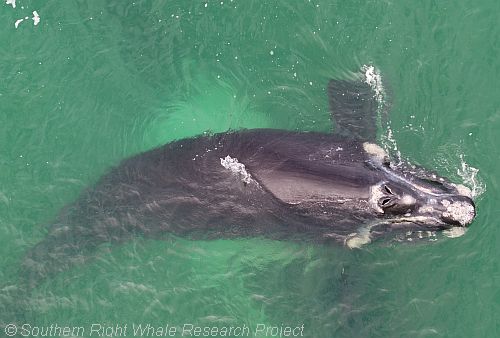
Calf of a new female named 'Left Bar' at Logans Beach. Image taken with RPAS as part of the calf survival recruitment study. Callosity patterns (white markings) are analysed to identify individual whales - Image: Southern Right Whale Research Project.
One drone flight was conducted on the 15 August 2024, when a cow-calf pair was in the Warrnambool area. Images of this cow-calf pair were taken in accordance with the conditions of the research permit (10010359) and CASA regulations.
Southern Right Whale calf survival, recruitment and movement study
A new study into Southern Right Whale calf survival, recruitment and movement commenced at Logans Beach in late August 2017. The study involves using Remotely Piloted Aircraft Systems (RPAS) or drones to obtain clear dorsal images of the callosity patterns of the calves and their mothers. The images collected will be used to identify, record and follow individual calves.
Using photo-identifications of calves born each year, the study hopes to find them again on the Australian coast during future winter breeding seasons. This information will be critical to understanding what factors may be affecting Southern Right Whale population growth and distribution in SE Australia. Ninety calves have been recorded at Logans Beach since the early 1980's but it’s not known what happens to these calves once they leave the coast and migrate to their sub-Antarctic feeding grounds.
In the four seasons (2017 -2020) ten calves were photographed and catalogued on the South West Victorian coast. It is hoped that when these calves return to the Australian coastline, as adults which could be up to 6 years’ time they can be identified from their callosities.
The data being collected will be added to the South East Australian Southern Right Whale Photo-Identification Catalogue (SEA SRW PIC).
In the 2022 and 2023 seasons a total of 42 Southern Right Whales were photo ID'd and added to the catalogue.
The research, funded with support from the Victorian Government is a partnership between DECA regional staff and Arthur Rylah Institute (ARI). A research permit (no. 10008394) under Section 78 (1) (c) of the Wildlife Act 1975 and Animal Ethics approval (AEC 17-006) were obtained for this project allowing us to operate the RPAS closer to whales than is normally allowed. In accordance with the Wildlife (Marine Mammals) Regulations 2009, RPAS or ‘drone’ operators are normally required to keep their craft a distance of at least 500m above and 500m horizontally from a whale. DEECA sourced fully qualified and experienced RPAS pilots and systems for this research and flights were conducted in accordance with CASA regulations. Close monitoring of whales was undertaken during RPAS flights to detect any behavioural responses to the RPAS.
- 2017 photo ID results
- 2018 photo ID results
- 2019 photo ID results
- 2020 photo ID results
- 2022 photo ID results
- 2023 photo ID results
Citizen Science
Citizen Science has become an integral part of the Southern Right Whale monitoring program. Reports are encouraged from public sightings. In addition, the use of high-quality images can assist in photo-ID. In 2017 Twenty-five members of the whale watching community from Victoria, South Australia and NSW provided data on 56 sighting events. This data resulted in 16 new whales for the catalogue plus 36 documented sightings of 18 of the 32 new whales identified.
In 2018, 24 of the 31 whales recorded were identified by citizen scientists. The Deakin University Whale watcher program had 27 volunteers undertaking whale watching 7 days a week at Logan’s Beach. View video.
Volunteers can now submit sightings and upload photos using the Whaleface sightings uploader hosted on SWIFFT.
Project support
Treloar Roses, located at Portland, Victoria helped to support the Southern Right Whale Photo Identification work during 2019. They developed a special rose named ‘Tangles’ after the successful disentanglement of a SRW nicknamed ‘Tangles’ at Portland in 2018.
Each sale of a Tangles rose supported the cataloguing and analyses of the large volume of incoming photographs which are used in this critical research.
Southern Right Whale records in Victoria
Highlights of whale sightings between 23 July to 17 August 2011
This summary of sightings between 23 July to 17 August 2011 was compiled from information provided by Mandy Watson, Senior Natural Resource Management Officer - Biodiversity, Department Sustainability and Environment, 78 Henna St Warrnambool 3280, Phone: (03) 55619961. Contact Mandy Watson for more detailed daily reports.
The Warrnambool Whale Watch Volunteer Project was made possible with the assistance of 22 volunteers.
The first sighting of a Southern Right Whale off Victoria's south west coastline for 2011 was 10 May at Logans Beach near Warrnambool.
Between 23 July and 17 August there have been many sightings of Southern Right Whales along the south-west coast of Victoria. Several sighting have included cow and calf pairs. Sightings are likely to continue until the end of October, possibly into early November.
Between 23 July and 18 August 2011 a cow and calf pair has been sighted virtually every day at Logans Beach, Warrnambool. Between 12 -17 August there was also another single sub-adult Southern Right Whale present.
Other interesting dates
- 23 July - Logans Beach; 3 x Southern Right Whales (including 1 x cow and calf pair and regular 'Big Lips')
- 23 July - 27 Jul -Port Fairy Bay; up to 6 Southern Right Whales including one grey
- 27 July - Codrington; 2 x Southern Right Whales
- 27 July - Portland; 1 x Southern Right Whale
- 28 July - Logans Beach; 4 x Southern Right Whales (including 1 x cow and calf pair and 2 adults)
- 30 July - Logans Beach 1 x Humpback Whale heading east
- 2 Aug - Port Fairy; 2 x Southern Right Whales
- 4 Aug - Cape Nelson; 1 x Southern Right Whales cow and calf pair plus 1-2 x Southern Right Whales adults
- 5 Aug - Bridgewater Bay; 1 x Southern Right Whale
- 5 Aug - Portland Bay; 2 x Southern Right Whales, adults (including 'White')
- 7 Aug - Portland harbour; 1 x adult Southern Right Whale
- 17 Aug - Cape Otway; unconfirmed reports of up to 5 Southern Right Whales off Light Station on 17 and 18 Aug and 3 in Portland harbour on 18 August.
On 4 August two Humpback Whales were sighted at Barwon Heads and another two at Port Phillip Heads. On 13 August 1 pod of Humpback Whales were seen in Port Phillip Bay. On 17 August 2-3 Humpback Whales were seen at Portland.
Last SRW Whale sighting at Logans Beach 28 August 2011.
Logans Beach conclusions
- Overall it was a quiet season with bad weather throughout June and July making observations difficult.
- Total number of individual whales = 16 minimum.
- At least 2 possibly 3 x cow calf pairs at Logans Beach during the season.
- Tripod present 10 May – 27 Aug (16 weeks = 109 days, calf = approx 12 weeks)
- Mating groups observed on 3 dates 1 Jul, 16 Jul, 20 Jul
- Maximum number of individual whales on a given day = 6 (including 1 x cc pair) at Logans Beach recorded on 1 July and 16 July.
Photo-ID results:
- 2 flights between Port Campbell and Bridgewater 27 July and 24 August.
- 27 July; 9 whales photographed (4 Port Fairy – SAG including one light grey, 2 Codrington – including Big Lips Checkerboard, 1 Portland, 2 Logans Beach – Tripod and calf)
- 24 August; 4 whales photographed (2 Bridgewater Bay – including ‘Bumps’, 2 Discovery Bay – Tripod and calf).
- Matching against catalogue yet to be done.
Summary 2012
The first sightings of Southern Right Whales occurred on 17 May 2012 at Barwon Heads. Since then there have been regular sightings along the south west Victorian coastline. Confirmed sightings of pairs of Southern Right Whales have occurred at Port Fairy, Logans Beach, south east of Portland, at Portland, Cape nelson. Four Southern Right Whales were recorded at Narrawong on 6 July. A confirmed Humpback Whale sighting was recorded at Cape Nelson on 4 July. There have been unconfirmed sightings of Humpbacks and Southern Right Whales reported off Bridgewater Bay, Cape Otway and Lorne during June-July.
Summary 2013
The first confirmed sightings of Southern Right Whales in Victoria occurred on 28 May 2013 at Port Fairy and the first cow and calf pair was recorded at Logans Beach on 9 June 2013. The last sightings for the season were on 5 October with a cow and calf pair at Logans Beach.
This year Southern Right Whales were observed at numerous sites along the Victorian coastline with validated sightings at Port Fairy, Portland, Bridgewater, Cape Nelson, Logans Beach, Port Fairy, Narrawong, Killarney, Apollo Bay, Lorne, Anglesea, Bells Beach, Jan Juc, Ocean Grove, Phillip Island, Wilsons Promontory, Lake Tyres, Cape Conran, Tamboon Inlet and Wingan Inlet.
A survey conducted on 31 August counted a total of 28 southern right whales in Victoria. These were located at Bridgewater, Logans Beach and far East Gippsland
Cow and calf pair sightings were made at Logans Beach, Port Campbell, Anglesea, Wilsons Promontory and near Lorne but Logans Beach was clearly Victoria's most important location with regular cow and calf sighting from July through to early October. There were numerous days when three cow and calf pairs were observed. During August up to five cow and calf pairs were present with 16 whales counted at Logans Beach on 28 August.
By using photo-matching it has been found that two of the three mothers are regular Warrnambool females. One of the females called 'Big Lips' was recorded with a calf at Logans Beach in 1995, 2002, 2005, 2009, 2013. The other female named 'Long Coaming' has been recorded with a calf at Logans Beach in 2001, 2006, 2009 and 2013.
Summary 2014
This summary was provided by Mandy Watson, Senior Natural Resource Management Officer - Biodiversity, Environment, Natural Resources and Fisheries, Barwon South West Region, Department of Environment and Primary Industries, Victoria.
Highlights
- 21 May first confirmed sighting - Cape Nelson.
- 28 May first Logan’s Beach sighting.
- 16 – 20 June first recorded calf - Portland.
- 3 July calf - Narrawong Beach (mother ID ‘Lotsadots’/SE0103) Pair resident at Logan’s Beach 11 Jul - 30 Jul. Also seen at Rutledge’s Cutting 4 & 5 Aug and Bridgewater 8 Aug, 25 Aug.
- 3 Aug calf - Portland (mother ID pending) - seen once.
- 15 Aug calf - Logan’s Beach (mother ID ‘Patch’s Mum’/SE0907). Mother seen without calf at Logan's Beach 22 Jul - 27 Jul and at Rutledge's Cutting 4 Aug. Pair resident at Logan's Beach 15 Aug - 26 Aug, last seen at Rutledge's Cutting 27 Aug.
- 22 Aug 3 x calves & 3 x single adults – Wilson’s Prom, 4 x single adults far East Gippsland (ID's pending).
- 30 Aug & 4 Sept calf - Anglesea/Barwon Heads (mother ID unknown).
- 7 Sept calf - Portland (mother ID pending).
- 12 Sept calf - Logan’s Beach (mother ID ‘Fang’/SE0402) Mother seen at Logan’s Beach without calf 25 Aug - 9 Sept. Pair resident at Logan's Beach 12 Sept - 12 Oct.
- 12 Oct last confirmed sighting - Logan’s Beach (‘Fang’ and calf).
A minimum total of 10 cow:calf pairs were confirmed during the 2014 season across the Victorian coast. 6 were recorded in the Warrnambool - Portland area, 1 in the Anglesea - Barwon Heads area and 3 at Wilson's Promontory. The last calf recorded at Logan's Beach this year was born between 9 - 12 Sept making it the latest calf on record.
Movements of individual whales have been documented courtesy of the DEPI photo-identification matching project (SEA SRW PIC) with ID contributions from a range of sources. The project acknowledges contributions of the Warrnambool Whale Watch volunteers and data contributors; P. Read, C. Farrell, Deakin University, B. McPherson, and M. Hartney.
2015 whale sightings
Summary 2015
This summary was provided by Many Watson (DELWP) 03 55 619961.
It's been a reasonably good season across the Victorian coast with plenty of opportunity to view southern right whales with from the Logans Beach viewing platform. Two Logans Beach regulars known as Big Coaming and Tripod were present with their calves throughout the months of July and August.
Big Coaming arrived on 18 June and was first spotted with her calf on 7 July. Tripod arrived on 7 July with her calf. It is estimated by their size that both calves were born around the beginning of July. Tripod and her calf left the area in late August followed by Big Coaming and her calf in early September. Both of these females have been identified (from the callosity pattern on the head) as having visited Logans Beach in at least 4 previous seasons. Tripod was first identified in 1995 and Big Coaming was first identified in 2001.
In addition to our resident females and calves a small number of single southern right whales made brief visits to Logans Beach. The maximum daily count at Logans Beach occurred on 16 August with 6 southern right whales (two cow:calf pairs plus 2 single adults) observed.
There were also numerous reports of travelling humpback whales and resting southern right whales in many of the usual bays along the coast throughout the season. Some unusual sightings this year include;
- A juvenile humpback whale in Corio Bay Geelong on 2 July
- A southern right whale in the bay at Port Campbell on 19 and 20 July
- A pod of killer whales spotted off Wilson's Prom on 1 July
- A sperm whale seen off Cape Otway on 26 Sept
- A humpback whale seen feeding off Portland in early during late Sept or early Oct (other details not available)
Weekly summaries
Below is a list of the confirmed reports from Department of Environment, Water, Land and Planning (DEWLP), Mandy Watson, Senior Biodiversity Officer.
We have had a lot of reports so far and of particular interest is the return of two of our regular female Southern Right Whales to the Logan's Beach nursery, Warrnambool and the safe arrival of their calves last week. These females are known as 'Big Coaming' and 'Tripod' based on their callosity patterns (individually unique white features on their heads)
Whale sightings summary (update issued 17 July 2015):
- 27 May Portland 1 x Humpback Whale (HBW)
- 31 May Logans Beach 1 x Southern Right Whales (SRW)
- 7 June Port Fairy 2 x HBW
- 9 June Portland 2 x HBW
- 13 June Logans Beach 3 x HBW
- 15 June Logans Beach 1 x SRW (sub-adult)
- 16 June Warrnambool 1 x SRW (sub-adult)
- 18 June Logans Beach 4 - 5 HBW
- 18 June Logans Beach 1 x SRW
- 19 June Logans Beach 1 x SRW (identified as Big Coaming)
- 22 June Logans Beach 1 x SRW (Big Coaming)
- 24 June Logans Beach 1 x SRW (Big Coaming)
- 25 June Logans Beach 1 x SRW (Big Coaming)
- 26 June Logans Beach 1 x SRW (Big Coaming)
- 27 June Logans Beach 1 x SRW (Big Coaming)
- 28 June Logans Beach 1 x SRW (Big Coaming)
- 29 June Logans Beach 1 x SRW (Big Coaming)
- 30 June Logans Beach 1 x SRW (Big Coaming)
- 1 Jul Wilson's Promontory light station 1 + Killer Whales
- 2 Jul Portland 1 x SRW
- 2 Jul Lake Gillear 1 x SRW
- 2 Jul Geelong 1 x HBW
- 3 Jul Portsea back beach 2 x HBW
- 6 Jul Bridgewater 2 x SRW
- 6 Jul Portsea back beach 1 + HBW
- 7 Jul Portland 4 x SRW
- 7 Jul Bridgewater 3 x SRW
- 7 Jul Peterborough 3 x HBW
- 8 Jul Princetown 6 + HBW
- 7 Jul Logans Beach 4 x SRW (1 x CC pair Big Coaming & min 2 others)
- 8 Jul Logans Beach 4 x SRW (2 x CC pairs Big Coaming & unidentified)
- 9 Jul Port Fairy 3 x SRW
- 11 Jul Portland 2 x SRW
- 11 Jul Logans Beach 4 x SRW (2 x CC pairs Big Coaming & Tripod)
- 13 Jul Logans Beach 3 x SRW (1 x CC pair Big Coaming & single adult)
- 14 Jul Portland 1 x SRW
- 14 Jul Logans Beach 3 x SRW (1 x CC pair Big Coaming & single adult)
- 16 Jul San Remo 1 x SRW
- 16 Jul Logans Beach 5 x SRW (2 x CC pairs & single adult)
SRW = Southern Right Whale
HBW = Humpback Whale
CC = Cow:Calf pair
Confirmed whale sightings for the week ending 24 July 2015 (update issued 27 July 2015)
- 19 Jul Logans Beach 5 x SRW (2 x CC pairs & single adult)
- 19 Jul Port Campbell 2 x SRW
- 20 Jul Logans Beach 4 x SRW (2 x CC pairs Big Coaming and Tripod)
- 20 Jul Port Campbell 1 x SRW
- 20 Jul Cape Nelson 3 x SRW
- 20 Jul Sorrento back beach 2 x HBW
- 21 Jul Logans Beach 4 x SRW (2 x CC pairs Big Coaming and Tripod)
- 21 Jul Sorrento back beach 1 x HBW
- 22 Jul Logans Beach 4 x SRW (2 x CC pairs Big Coaming and Tripod)
- 23 Jul Logans Beach 4 x SRW (2 x CC pairs Big Coaming and Tripod)
- 24 Jul Logans Beach 4 x SRW (2 x CC pairs Big Coaming and Tripod)
- 24 Jul Port Fairy 2 x HBW
There are unconfirmed reports of southern right whales at Apollo Bay and Aireys Inlet over the weekend and a pod of killer whales near Port Campbell last Tuesday. Further information is being obtained to confirm these reports. If anyone has photos of further information regarding these unconfirmed reports please contact Mandy Watson (DEWLP) 03 55 619961.
Confirmed whale sightings for the week ending 31 July 2015
- 22 Jul Wilson's Promontory 1 x SRW
- 25 Jul Logans Beach 4 x SRW (2 x CC pairs Big Coaming and Tripod)
- 26 Jul Logans Beach 4 x SRW (2 x CC pairs Big Coaming and Tripod)
- 27 Jul Logans Beach 4 x SRW (2 x CC pairs Big Coaming and Tripod)
- 27 Jul Wilson's Promontory 2 x SRW
- 28 Jul Logans Beach 4 x SRW (2 x CC pairs Big Coaming and Tripod)
- 28 Jul Apollo Bay 2 x SRW
- 29 Jul Logans Beach 4 x SRW (2 x CC pairs Big Coaming and Tripod)
- 29 Jul Cape Paterson 1 x SRW
- 30 Jul Logans Beach 4 x SRW (2 x CC pairs Big Coaming and Tripod)
- 31 Jul Logans Beach 4 x SRW (2 x CC pairs Big Coaming and Tripod)
Unconfirmed reports for week ending 31 July 2015
There are several unconfirmed reports of southern right whales in the Lorne/Stony Creek/Airey's Inlet area during the week.
Confirmed whale sightings for the week ending 7 August 2015
- 1 Aug Logans Beach 4 x SRW (2 x CC pairs Big Coaming and Tripod)
- 2 Aug Logans Beach 4 x SRW (2 x CC pairs Big Coaming and Tripod)
- 2 Aug 1 x SRW Port Fairy
- 2 Aug 1 x SRW Portland
- 3 Aug Logans Beach 4 x SRW (2 x CC pairs Big Coaming and Tripod)
- 4 Aug Logans Beach 4 x SRW (2 x CC pairs Big Coaming and Tripod)
- 5 Aug Logans Beach 4 x SRW (2 x CC pairs Big Coaming and Tripod)
- 6 Aug Logans Beach 4 x SRW (2 x CC pairs Big Coaming and Tripod)
- 7 Aug Logans Beach 4 x SRW (2 x CC pairs Big Coaming and Tripod)
Confirmed whale sightings for the week ending 14 August 2015
- 7 Aug Warrnambool 1 x HBW
- 8 Aug Logans Beach 4 x SRW (2 x CC pairs Big Coaming and Tripod)
- 9 Aug Logans Beach 4 x SRW (2 x CC pairs Big Coaming and Tripod)
- 10 Aug Logans Beach 4 x SRW (2 x CC pairs Big Coaming and Tripod)
- 10 Aug Pearl Point east Gippsland min 2 x SRW
- 11 Aug Logans Beach 4 x SRW (2 x CC pairs Big Coaming and Tripod)
- 12 Aug Logans Beach 4 x SRW (2 x CC pairs Big Coaming and Tripod)
- 13 Aug Logans Beach 4 x SRW (2 x CC pairs Big Coaming and Tripod)
- 14 Aug Logans Beach 4 x SRW (2 x CC pairs Big Coaming and Tripod)
Confirmed whale sightings for the week ending 21 August 2015
- 15 Aug Logans Beach 4 x SRW (2 x CC pairs Big Coaming and Tripod)
- 16 Aug Logans Beach 6 x SRW (2 x CC pairs Big Coaming and Tripod plus 2 adults)
- 16 Aug Seaspray 2 x SRW
- 17 Aug Logans Beach 4 x SRW (2 x CC pairs Big Coaming and Tripod)
- 17 Aug Port Fairy 1 x SRW
- 18 Aug Logans Beach 4 x SRW (2 x CC pairs Big Coaming and Tripod)
- 19 Aug Logans Beach 4 x SRW (2 x CC pairs Big Coaming and Tripod)
- 20 Aug Logans Beach 4 x SRW (2 x CC pairs Big Coaming and Tripod)
Confirmed whale sightings for the week ending 28 August 2015
- 21 Aug Logans Beach 4 x SRW (2 x CC pairs Big Coaming and Tripod)
- 22 Aug Logans Beach 4 x SRW (2 x CC pairs Big Coaming and Tripod)
- 22 Aug Ninety Mile Beach 2 x SRW
- 23 Aug Logans Beach 4 x SRW (2 x CC pairs Big Coaming and Tripod)
- 23 Aug Portland 1 x SRW
- 24 Aug Logans Beach 4 x SRW (2 x CC pairs Big Coaming and Tripod)
- 25 Aug Logans Beach 4 x SRW (2 x CC pairs Big Coaming and Tripod)
- 26 Aug Logans Beach 4 x SRW (2 x CC pairs Big Coaming and Tripod)
- 27 Aug Logans Beach 4 x SRW (2 x CC pairs Big Coaming and Tripod)
Confirmed whale sightings for the week ending 4 September 2015
- 29 Aug Logans Beach 4 x SRW (2 x CC pairs Big Coaming and Tripod)
- 30 Aug Logans Beach 3 x SRW (1 x CC pair Big Coaming plus single adult)
- 31 Aug Logans Beach 2 x SRW (1 x CC pair Big Coaming)
- 1 Sept Logans Beach 2 x SRW (1 x CC pair Big Coaming)
- 2 Sept Logans Beach 2 x SRW (1 x CC pair Big Coaming)
- 3 Sept Logans Beach 2 x SRW (1 x CC pair Big Coaming)
- 4 Sept Logans Beach 2 x SRW (1 x CC pair Big Coaming)
Confirmed whale sightings for the week ending 11 September 2015
- 5 Sept Logans Beach 2 x SRW (1 x CC pair Big Coaming)
- 6 Sept Logans Beach 3 x SRW (1 x CC pair Big Coaming plus single adult)
- 7 Sept Logans Beach 3 x SRW (1 x CC pair Big Coaming plus single adult)
- 8 Sept Logans Beach 3 x SRW (1 x CC pair Big Coaming plus single adult)
- 9 Sept Logans Beach 2 x SRW (1 x CC pair Big Coaming)
- 10 Sept no sightings
- 11 Sept no sightings
Confirmed whale sightings for the week ending 18 September 2015
- No confirmed sightings reported to DELWP over the last week.
2016 whale sightings
2016 Summary
This summary of sightings between 16 May to 29 August 2016 was compiled from information provided by Mandy Watson, Senior Project Officer Wildlife Emergencies|Biodiversity Division Department of Environment, Land, Water and Planning, 703 - 709 Raglan Parade, Warrnambool 3280, Phone: (03) 55619961.
Official volunteer whale watching commenced in April 2016 with a slow start to the season. The first unconfirmed whale sighting was on 7 April at Port Fairy and the first confirmed Southern Right Whale sighting for the season being on 21 May at Apollo Bay.
Only two Southern Right Whale females with calves were recorded in Victorian waters this season. Both of these were matched with previously identified females in the SE Australian photo-ID catalogue (SEA SRW PIC).
One of these females, known as 'Bonnet' is a regular from Logans Beach, having been recorded there with calves in 2002 and 2009. 'Bonnet' arrived at Logans Beach amongst a group of other adults on 10 July and disappeared the following day. She re-appeared at Logan's Beach on 18 July with a calf, but again stayed for only one day. She was not identified again until 7 August where she was photographed at Skene's Creek, although a female with calf had been reported in the Lorne area on 5 August. 'Bonnet' and her calf re-appeared at Logans Beach on 20 August and were last seen there on 22 August.
The other female with calf was recorded at Portland and is relatively new to the catalogue. She has only been recorded once before - in Tasmania - also with a calf. This female was first reported to DELWP with a calf on 19 July at Portland and the pair was regularly observed there (mostly off Dutton Way), until 29 August, a total minimum of 42 days.
In addition to the two nursing females a large mating group of up to 7 adult southern right whales appears to have moved up and down the coast through the season. These whales were first reported at Logans Beach on 10 July, then at Port Fairy on 16 and 18 July. It appears they may have moved east from there, as mating groups were seen at Wye River on 24 July and Point Addis on 27 July. Up to 7 were seen at Port Fairy on 16 and 17 August, and 5 were seen at Portland on 22 August. Photo-ID matching has not yet been completed to confirm if these were all part of the same group, but the behaviours, locations and sequence of sightings would suggest they were. Interestingly a large mating group showed up in the Encounter Bay area in South Australia at the end of August.
Other interesting sightings include;
- a large pod of Killer Whales at Flinders on 4 July.
- a young Southern Right Whale approaching a whale watching vessel at Phillip Island on 9 July
- a pair of Southern Right whales near Mallacoota 6 - 7 August.
- 2016 photo ID results
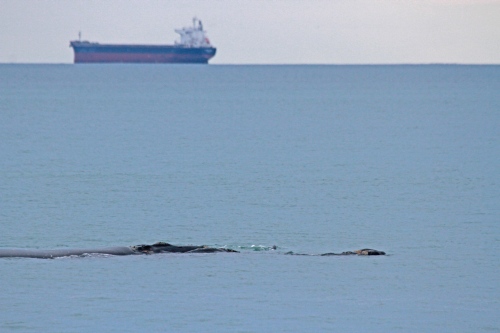
Southern Right Whale (cow and calf pair) at Portland on 5 August 2016. Image: Bob McPherson
2016 Weekly summaries
These are confirmed reports from Department of Environment, Water, Land and Planning (DEWLP), Mandy Watson, Senior Biodiversity Officer.
Confirmed whale sightings for the week ending 12 July 2016
- 16 May Mallacoota 1 x Killer Whale
- 21 May Apollo Bay 1 x SRW
- 5 Jun Portland 2 x SRW
- 13 Jun Phillip Island 1 x SRW
- 13 Jun Skenes Creek 1 x SRW
- 15 Jun Cape Patton 2 x HBW
- 19 Jun Port Phillip Bay 1 x SRW
- 4 Jul Phillip Island and Mornington Peninsular 15 x Killer Whales
- 9 Jul Phillip Island 1 x SRW
- 10 Jul Logans Beach 4 x SRW
- 11 Jul Logans Beach 1 x SRW
- 12 Jul Portland 3 x SRW
Confirmed whale sightings for the week ending 22 July 2016
- 16 Jul Port Fairy 4 x SRW
- 18 Jul Port Fairy 4 - 5 x SRW
- 18 Jul Logans Beach 1 x CC pair SRW
- 18 Jul Flinders 1 - 2 x SRW
- 19 Jul Portland 1 x CC pair SRW
- 20 Jul Portland 1 x CC pair SRW
- 21 Jul Portland 1 x CC pair SRW
- 22 Jul Portland 1 x CC pair SRW
Confirmed whale sightings for the week ending 29 July 2016
- 23 Jul 1 x CC pair SRW Portland
- 24 Jul 1 x CC pair SRW Portland
- 24 Jul 2 -3 x Adult SRW Wye River
- 25 Jul 1 x CC pair SRW Portland
- 27 Jul 1 x CC pair SRW Portland
- 27 Jul 4-5 x SRW Adults Point Addis
- 28 Jul 1 x CC pair SRW Portland
- 29 Jul 1 x CC pair SRW Portland
Confirmed whale sightings for the week ending 5 August 2016
- 30 Jul 1 x SRW Logans Beach
- 30 Jul 1 x SRW CC pair Portland
- 30 Jul 3 x SRW Lorne
- 31 Jul 1 x SRW CC pair Portland
- 3 Aug 1 x SRW CC pair Portland
- 4 Aug 1 x SRW CC pair Portland
- 4 Aug 2 x SRW Lorne
- 5 Aug 4 x SRW Lorne (2 adults & 1 x CC pair)
- 5 Aug 1 x SRW CC pair
Confirmed whale sightings for the week ending 12 August 2016
- 5 Aug 1 x SRW CC pair Big Tree Hill
- 5-8 Aug 2 x SRWs at Mallacoota
- 6 Aug 5 x SRW Apollo Bay (Adults in mating group)
- 7 Aug 1 x SRW CC pair Skene's Creek
- 7 Aug 1 x SRW Logans Beach (sub-adult)
- 7 Aug 1 x SRW CC pair Portland
- 9 Aug 1 x SRW CC pair Portland
- 10 Aug 1 x SRW CC pair Portland
- 11 Aug 1 x SRW CC pair Portland
- 12 Aug 1 x SRW CC pair Portland
The whale identification catalogue and contributions from volunteer photographers has enabled Mandy to identify two cow:calf pairs that we currently have on our coast. Firstly the female with calf near Lorne has been identified as 'Bonnet', a whale who has been recorded at Logans Beach with calves in two previous years; 2002 and 2009. The female with a calf at Portland does not have a name but was identified in Tasmania 3 years ago where she was photographed with a calf at Southport on the far south east coast. This whale is new to the Victorian photo-identification catalogue.
Confirmed whale sightings for the week ending 19 August 2016
- 12 Aug 2 x HBW Logans Beach
- 12 Aug 1 x SRW CC pair Separation Creek
- 13 Aug 1 x SRW CC pair Portland
- 14 Aug 1 x SRW CC pair Portland
- 15 Aug 2 x SRW Logan's Beach
- 15 Aug 1 x SRW CC pair Portland
- 16 Aug 1 x SRW CC pair Portland
- 16 Aug 5 x SRW Port Fairy
- 17 Aug 7 x SRW Port Fairy
- 18 Aug 7 x SRW Port Fairy
- 18 Aug 1 x SRW CC pair Portland
Confirmed whale sightings for the week ending 26 August 2016
- 20 Aug 1 x SRW CC pair Logans Beach
- 20 Aug 1 x SRW CC pair Portland
- 21 Aug 3 x SRW Adults Yambuk
- 22 Aug 1 x SRW CC pair Logans Beach
- 22 Aug 1 x SRW CC pair plus 3 x Adults SRW Portland
- 24 Aug 2 x SRW Portland
- 25 Aug 1 x SRW CC pair Portland
%20500.jpg)
A two-metre long juvenile male Pygmy Right Whale (Caperea marginata) was found washed up dead at The Cutting near Killarney Beach west of Warrnambool on 26 August.
Confirmed whale sightings for the week ending 2 Septmber 2016 (final report for 2016)
- 27 Aug 1 x SRW CC pair Portland
- 28 Aug 1 x SRW CC pair Portland
- 29 Aug 1 x SRW CC pair Portland
SWIFFT wishes to thank Mandy and the volunteers for their sightings and confirmation of reports.
Results from the 2016 photo-ID matching for the South East Australian Photo Identification Catalogue (SEA SRW PIC) project.
Summary from Mandy Watson, Senior Biodiversity Officer, Barwon South West - Forest, Fire and Regions, Department of Environment, Land, Water and Planning
A total of 23 photographed sightings 'events' were received from different 14 contributors from Victoria and NSW during the 2016 season. From these 23 events, 14 different whale IDs were obtained. Of the 14 IDs, twelve were whales which are new to the catalogue and two were whales from previous years. Both of these re-sights involved cow and calf pairs, one known as 'Bonnet' a regular from Logans Beach and one which spent this season at Portland was first identified in Tasmania in 2013. The remaining 12 whales were adults without calves.
19 of the 23 photographed sightings events involved the remaining 12 IDs, which means that some whales were photographed on more than one occasion at more than one location. One whale photographed near Gabo Island in far East Gippsland was photographed again off Kilcunda in South Gippsland 8 days later. 5 whales ID'd this year were part of a large mating group which moved west along the Victorian coast from Anglesea to Apollo Bay to Port Fairy then Yambuk over a 3 - 4 week period.
This photo-ID research provides valuable insights into habitat use and population trends within South East Australia.
Mandy acknowledges the valuable contributions received from observers which is fundamental to the project's success.
2017 Whale sightings
Summary of 2017 Whale season in Victoria adapted from information provided by Mandy Watson, Senior Biodiversity Officer, Barwon South West, Department of Environment, Water, Land and Planning (DEWLP).
2017 has been one of the biggest years on record for both Southern Right Whale and Humpback Whales in western Victoria with sightings reported from early May through to late October.
Summary of key dates in 2017
- 7 May - first Southern Right Whale sightings for the season at Cape Bridgewater and Logans Beach.
- 22 May onwards - almost daily sightings of Southern Right Whales at Logans Beach.
- 23 May – a regular breeding female, 'Big Lips' was identified
- 3 June - 'Big Lips' was photographed with a calf.
- 4 June - a second cow and calf pair at Logans Beach. The mother named 'Thin Lips' was previously recorded at Logans Beach in 2013.
- 1 July – a third cow and calf pair at Logans Beach. The mother named 'Long Coaming' is another Logans Beach regular.
- 7 July – a fourth cow and calf pair at Logans Beach. The mother named 'No Lips Black' is new to Logans Beach but was previously recorded in Tasmania in 2009.
- 9 Aug - 5 cow:calf pairs were observed at Logans Beach. The 5 th cow:calf pair being new to the catalogue.
- 22 Aug - 6 pairs were recorded; The 6 th cow:calf pair being new to the catalogue.
- 13 August – a different cow:calf pair reported in the Killarney area. This pair settled at a small bay known as The Basin for the remainder of the season and were the last of the cow:calf pair to leave western Victoria. They were last spotted near The Basin on 25 September.
- 22 October - the last Southern Right Whale sighting for the season was a single sub-adult seen at Cape Nelson near Portland.
Mandy extends thanks to all the whale watch volunteers and data contributors who provided information to support the Southern Right Whale research program in 2017.
Results from the 2017 photo-ID matching for the South East Australian Photo Identification Catalogue (SEA SRW PIC) project.
The photo-identification research program recorded seven different nursing females in south west Victoria this year, along with a number of single (or unaccompanied) whales. Four of the nursing females are re-sights from previous years while three are new to the photo-ID catalogue. A number of the unaccompanied whales seen at Logans beach were sub-adults and unusually, there was extended interaction over days and weeks observed between these young whales and the nursing females and their calves. Separate socially active groups of adults were also observed on numerous days at both Logans Beach and around Portland.
Summary
- 56 sightings events contributed by citizen science
- 32 individual whales identified
- 28 new whales added to the catalogue and 4 re-sights (identified in previous seasons) added to the catalogue, including Logans Beach regular breeding females; Big Lips, Long Coaming and Thin Lips and a female first identified in Tasmania in 2009 - No Lips Black. Between them, these 4 females have produced a minimum of 14 calves at Logans Beach.
- Big Lips - 6 calves
- Long Coaming - 5 calves
- Thin Lips - 2 calves
- No Lips Black - 1 calf
Remotely Piloted Aircraft Systems (RPAS) project
In 2017, the DELWP Southern Right Whale photo-identification research program incorporated the use of remotely piloted aircraft systems (RPAS) or 'drones'. 12 of the 28 new whales identified this year were photographed during over a 2-day period.
Citizen Science
2017 was a hugely successful year for citizens science contributions to the SE Australian SRW Photo-identification research project. Twenty five members of the whale watching community from Victoria, South Australia and NSW provided data on 56 sighting events. This data resulted in 16 new whales for the catalogue plus 36 documented sightings of 18 of the 32 new whales identified.
Weekly sightings 2017
These are confirmed reports from Department of Environment, Water, Land and Planning (DEWLP), Mandy Watson, Senior Biodiversity Officer, Warrnambool.
Confirmed whale sightings to 10 May 2017
- 4 May Cape Nelson 2 x Blue Whales
- 7 May Logans Beach 1 x SRW
- 7 May Bridgewater Bay 1 x SRW
- 7 May Bridgewater Bay 1 x Killer Whale
- 9 May Cape Nelson 1 x SRW
- 10 May Bridgewater Bay 1 x SRW
Confirmed whale sightings to 10 May 2017
- 16 May Tidal River Wilson's Promontory 1x Pygmy Sperm Whale mother and calf pair, stranded alive but both died despite rescue efforts.
Confirmed whale sightings to 26 May 2017
- 22 May *Logan's Beach 1 x SRW - tracked east to Thunder Pont then to Rutledge's Cutting then back to Warrnambool same day
- 23 May *Logan's Beach 2 x SRW (1 x adult and 1 x sub-adult interacting)
- 24 May *Logan's Beach 1 x SRW
- 24 May Port Campbell 1 x SRW
- 25 May *Logan's Beach 1 x SRW
- 26 May Jan Juc 1 x SRW
- 26 May *Logan's Beach 1 x SRW
* All Logan's Beach sightings have involved the same adult whale.
Confirmed whale sightings to 2 June 2017
- 28 May Rye back beach 1 x HBW
Confirmed whale sightings to 9 June 2017
The 2017 breeding season in SW Victoria has officially started with the arrival of two calves at Logans Beach last weekend (3 & 4 June). Both mother:calf pairs seem to have settled into the nursery where it is hoped they remain for the season.
Mandy Watson (DELWP) has confirmed that one of these pairs is a Logans Beach regular female known as 'Big Lips' and her newborn calf. Big Lips has been previously recorded 7 times at Logans beach and is known to have produced at least 6 calves here. Work on identifying the other female is underway to see if she is known to the photo-ID catalogue or is a new whale.
- 3 June Logans Beach 1 x SRW CC pair
- 3 June Logans Beach 2 x HBW heading east
- 4 June Logans Beach 2 x SRW CC pairs
- 4 June Portland 1 x SRW
- 5 June Logans Beach 2 x SRW CC pairs
- 6 June Logans Beach 2 x SRW CC pairs
- 7 June Logans Beach 2 x SRW CC pairs
- 8 June Logans Beach 2 x SRW CC pairs
- 9 June Logans Beach 2 x SRW CC pairs
Confirmed whale sightings to 16 June 2017
It's been another big week for whales in Victoria with daily sightings of the 2 Southern Right Whale cow calf pairs at Logans Beach plus sightings of other Southern Right whales at Lorne and Portland.
With the help of local photographers, Mandy has been able to identify two individual whales at Logans Beach. One female being ‘Big Lips’ and the second female identified as 'Thin Lips'. Both 'Big Lips' and 'Thin Lips' were at Logans Beach with calves in 2013. This is interesting because the normal calving interval is 3 years not 4. 2013 was a big year for calves at Logans Beach; 5 were recorded that year. It is possible that more females and calves could arrive at Logans Beach this season.
There has also been a big spike in the number of Humpback Whales seen along the coast this past week. These whales are all headed up the east coast as part of the annual Humpback Whale migration from Antarctic waters to the waters of northern Queensland.
- 9 June Portland 2 x SRW
- 9 June Lorne 1 x SRW
- 10 June Logans Beach 2 x SRW CC pairs
- 11 June Logans Beach 2 x SRW CC pairs
- 11 June Logans Beach 6 x HBW
- 11 June Portland 5 x HBW
- 11 June Lorne 2 x HBW
- 12 June Logans Beach 2 x SRW CC pairs
- 12 June Logans Beach 12 x HBW
- 13 June Logans Beach 2 x HBW
- 13 June Logans Beach 2 x SRW CC pairs
- 14 June Logans Beach 2 x SRW CC pairs
- 14 June Logans Beach 2 x HBW
- 15 June Logans Beach 2 x SRW CC pairs
SRW = Southern Right Whale
HBW = Humpback Whale
CC = Cow:Calf pair
Confirmed whale sightings to 22 June 2017
Mandy Watson has advised that she has received anecdotal reports of many more Humpback whales than what is reported below, as well as reports of unidentified species. Unfortunately these cannot be entered into the sightings database unless they are confirmed so please send images to Mandy where possible.
Below is a list of confirmed sightings reports over the past week:
- 15 June Point Hicks, East Gippsland 13 x HBW
- 16 June Port Phillip Bay 2 x HBW
- 16 June Bridgewater, The Blowholes 6 x HBW
- 16 June Logans Beach 2 x SRW CC pairs
- 17 June Logans Beach 2 x SRW CC pairs
- 17 June Pyramid Rock, Phillip Island 1 x SRW
- 17 June London Bridge, Portsea 1 x HBW
- 18 June Logans Beach 2 x SRW CC pairs
- 19 June Logans Beach 2 x SRW CC pairs
- 20 June Logans Beach 2 x SRW CC pairs
- 20 June Logans Beach 2 x HBW
- 21 June Logans Beach 5 x SRW (2 x CC pairs, 1 adult)
- 22 June Logans Beach 5 x SRW (2 x CC pairs, 1 adult)
Confirmed whale sightings to 30 June 2017
- 22 June Point Nepean 3 x HBW
- 23 June Logans Beach 5 x SRW (2 x CC pairs, 1 adult)
- 24 June Logans Beach 2 x SRW (1 x CC pair)
- 25 June Logans Beach 3 x SRW (1 x CC pair, 1 x adult)
- 26 June Logans Beach 3 x SRW (1 x CC pair, 1 x adult)
- 27 June Logans Beach 5 x SRW (1 x CC pair, 3 x adult)
- 28 June Logans Beach 5 x SRW (1 x CC pair, 3 x adult)
- 28 June Portland 1 x SRW
- 28 June Phillip Island 1 x SRW
- 29 June Logans Beach 7 x SRW (2 x CC pairs, 3 x adult)
- 29 June Logans Beach 3 x HBW
- 30 June Logans Beach 7 x SRW (2 x CC pairs, 3 x adult)
Confirmed whale sightings to 7 July 2017
- 1 July Logans Beach 7 x SRW (3 x CC pair, 1 x adult)
- 1 July Port Fairy 1 - 2 x SRW (possibly CC pair)
- 1 July Portland 2 x SRW
- 2 July Logans Beach 10 x SRW (3 x CC pair, 4 x adults)
- 2 July Cape Nelson 4 x HBW
- 3 July Logans Beach 8 x SRW (3 x CC pair, 2 x adult)
- 3 July Portland 5 x SRW
- 3 July Port Fairy 1 x SRW
- 4 July Logans Beach 9 x SRW (3 x CC pair, 3 x adult)
- 5 July Logans Beach 9 x SRW (3 x CC pair, 3 x adult)
- 6 July Logans Beach 10 x SRW (3 x CC pair, 4 x adult)
- 6 July Logans Beach 15 x HBW
- 6 July Warrnambool 2 x HBW
- 7 July Logans Beach 11 x SRW (3 x CC pair, 6 x adult)
Confirmed whale sightings to 14 July 2017
- 8 July Logans Beach 10 x SRW (3 x CC pair, 4 x adult)
- 9 July Logans Beach 10 x SRW (3 x CC pair, 4 x adult)
- 9 July Portsea back beach 2 - 3 HBW
- 10 July Logans Beach 8 x SRW (3 x CC pair, 2 x adult)
- 11 July Logans Beach 8 x SRW (3 x CC pair, 2 x adult)
- 12 July Logans Beach 11 x SRW (3 x CC pair, 5 x adult)
- 14 July Logans Beach 11 x SRW (3 x CC pair, 5 x adult)
- 14 Juy Portland 1 x SRW
- 14 July Cape Woolamai 1 x SRW
Confirmed whale sightings to 21 July 2017
- 15 July Logans Beach 11 x SRW (3 x CC pair, 5 x adult)
- 15 July Port Campbell 2 - 3 HBW
- 15 July Portsea 2 x HBW
- 16 July Logans Beach 9 x SRW (3 x CC pair, 3 x adult)
- 16 July Point Addis 2 x HBW
Confirmed whale sightings to 28 July 2017
- 18 July Logans Beach 11 x SRW (4 x CC pair, 3 x adult)
- 19 July Logans Beach 11 x SRW (4 x CC pair, 3 x adult)
- 20 July Logans Beach 11 x SRW (4 x CC pair, 3 x adult)
- 20 July Apollo Bay 1 x SRW
- 21 July Logans Beach 14 x SRW (4 x CC pair, 6 x adult)
- 21 July The Crags 15 x HBW
Confirmed whale sightings to 4 August 2017
- 22 July Logans Beach 11 x SRW (4 x CC pair, 3 x adult)
- 22 July Port Fairy 4 x SRW
- 23 July Logans Beach 12 x SRW (4 x CC pair, 4 x adult)
- 23 July Port Fairy 4 x SRW
- 24 July Port Fairy 4 x SRW
- 24 July b/w Somers and Cowes 2 x SRW
- 25 July Port Fairy 2 x SRW
- 27 July Portland 3 x SRW
- 30 July Western Port Bay 3 x SRW
- 31 July Cowes 3 x SRW
- 2 Aug Logans Beach 12 x SRW (4 x CC pair, 4 x adult)
- 3 Aug Logans Beach 14 x SRW (4 x CC pair, 6 x adult)
- 3 Aug Cape Nelson 1 x SRW adult
- 4 Aug Portland 2 x SRW adult
- 4 Aug Logans Beach 14 x SRW (4 x CC pair, 6 x adult)
Confirmed whale sightings to 11 August 2017
- 5 Aug Logans Beach 10 x SRW (4 x CC pair, 2 x adult)
- 5 Aug San Remo 2 x SRW (1 x CC pair)
- 6 Aug Logans Beach 12 x SRW (4 x CC pair, 4 x adult)
- 7 Aug Logans Beach 12 x SRW (4 x CC pair, 4 x adult)
- 9 Aug Logans Beach 17 x SRW (5 x CC pair, 7 adult)
- 10 Aug Logans Beach 12 x SRW (4 x CC pair, 4 x adult)
- 10 Aug Port Fair 1 x SRW adult
- 10 Aug Portland 5 x SRW adult
- 11 Aug Logans Beach 13 x SRW (5 x CC pair, 3 x adult)
Confirmed whale sightings to 18 August 2017
- 12 Aug Logans Beach 8 x SRW (4 x CC pair)
- 13 Aug Logans Beach 8 x SRW (4 x CC pair)
- 13 Aug Armstrong Bay 2 x SRW (1 x CC pair)
- 13 Aug Port Campbell 2 x SRW (2 x adult)
- 14 Aug Logans Beach 10 x SRW (4 x CC pair, 2 x adult)
- 14 Aug Armstrong Bay 2 x SRW (1 x CC pair)
- 15 Aug Logans Beach 8 x SRW (4 x CC pair)
- 15 Aug Walkerville 3 - 7 x SRW
- 15 Aug Armstrong Bay 2 x SRW (1 x CC pair)
- 16 Aug Logans Beach 8 x SRW (4 x CC pair)
- 17 Aug Logans Beach 8 x SRW (4 x CC pair)
- 17 Aug Peterborough 2 x SRW (2 x adult)
- 18 Aug Logans Beach 10 x SRW (5 x CC pair)
Confirmed whale sightings to 25 August 2017
- 19 Aug Logans Beach 15 x SRW (7 x CC pair, 1 x adult)
- 20 Aug Logans Beach 13 x SRW (6 x CC pair, 1 x adult)
- 20 Aug Cape Nelson 1 x SRW adult
- 21 Aug Logans Beach 11 x SRW (5 x CC pair, 1 x adult)
- 22 Aug Logans Beach 16 x SRW (6 x CC pair, 4 x adult)
- 23 Aug Logans Beach 15 x SRW (5 x CC pair, 5 x adult)
- 24 Aug Logans Beach 13 x SRW (5 x CC pair, 3 x adult)
- 24 Aug Armstrong Bay 2 x SRW (1 x CC pair)
- 24 Aug Portland 1-2 x SRW
- 25 Aug Logans Beach 12 x SRW (5 x CC pair, 2 x adult)
- 25 Aug Killarney 2 x SRW (1 x CC pair)
Confirmed whale sightings to 8 September 2017
- 1 Sept Logans Beach 11 x SRW (5 x CC pair, 1 x adult)
- 1 Sept Armstrong Bay 2 x SRW (1 x CC pair)
- 2 Sept Logans Beach 13 x SRW (5 x CC pair, 3 x adult)
- 2 Sept Port Albert South Gippsland 2 x SRW adults
- 3 Sept Logans Beach 9 x SRW (4 x CC pair, 1 x adult)
- 3 Sept Portland 2 x SRW adults
- 4 Sept Logans Beach 11 x SRW (4 x CC pair, 3 x adult)
- 4 Sept Cape Nelson 2 x SRW adults
- 5 Sept Logans Beach 3 x SRW (1 x CC pair, 1 x adult)
- 6 Sept Logans Beach 4 x SRW (1 x CC pair, 2 x adult)
- 7 Sept Logans beach 8 x SRW (4 x CC pair)
In late August 2017 new research commenced on Southern Right Whale calf survival, recruitment and movement at Logans Beach
Confirmed whale sightings to 15 September 2017
- 8 Sept Logans Beach 8 x SRW (3 x CC pair, 2 x single adult)
- 9 Sept Logans Beach 8 x SRW (3 x CC pair, 2 x single adult)
- 10 Sept Logans Beach 6 x SRW (3 x CC pair)
- 11 Sept Logans Beach 4 x SRW (2 x CC pair)
- 11 Sept Armstrong Bay 2 x SRW (1 x CC pair)
- 12 Sept Logans Beach 10 x SRW (4 x CC pair, 2 x single adult)
- 13 Sept Logans beach 4 x SRW (2 x CC pair)
- 13 Sept Armstrong Bay 2 x SRW (1 x CC pair)
- 14 Sept Logans Beach 6 x SRW (2 x CC pair, 2 x single adult)
- 14 Sept Armstrong Bay 2 x SRW (1 x CC pair)
Confirmed whale sightings to 22 September 2017
- 15 Sept Logans Beach 5 x SRW (2 x CC pair, 1 x adult)
- 15 Sept Armstrong Bay 2 x SRW (1 x CC pair)
- 16 Sept Logans Beach 6 x SRW ( 2 x CC pair, 2 x adult)
- 16 Sept Armstrong Bay 2 x SRW (1 x CC pair)
- 17 Sept Logans Beach 3 x SRW (1 x CC pair, 1 x adult)
- 17 Sept Lady Bay Warrnambool 2 x SRW (1 x CC pair)
- 17 Sept Armstrong Bay 2 x SRW (1 x CC pair)
- 18 Sept Logans Beach 4 x SRW (1 x CC pair, 2 x adult)
- 19 Sept Armstrong Bay 2 x SRW (1 x CC pair)
- 20 Sept Armstrong Bay 2 x SRW (1 x CC pair)
- 20 Sept Port Fairy 3 x SRW adults
- 21 Sept Armstrong Bay 2 x SRW (1 x CC pair)
- 21 Sept Portland 2 x SRW adults
- 22 Sept Armstrong Bay 2 x SRW (1 x CC pair)
Confirmed whale sightings to 23 September to 26 October 2017
- 23 Sept Armstrong Bay 2 x SRW (1 x CC pair)
- 23 Sept Portland 1 x SRW adult
- 24 Sept Armstrong Bay 2 x SRW (1 x CC pair)
- 25 Sept Armstrong Bay 2 x SRW (1 x CC pair)
- 29 Sept Portland 2 x SRW (1 x CC pair)
- 18 Oct Wilson's Promontory 3 x HBW (1 x CC pair, 1 x adult)
- 21 Oct Logans Beach 2 x SRW adults
- 22 Oct Cape Nelson 1 x SRW adult
- 25 Oct Cape Nelson 4 x HBW
- 26 Oct Cape Nelson 6 x HBW (1 x CC pair, 4 x adult)
The Southern Right Whale season along the Victorian is considered over for 2017.
2018 whale sightings
Summary of 2018 season
Report adapted from information provided by Mandy Watson | Natural Environment Programs Officer | Barwon South West, Department of Environment, Land, Water & Planning, Victoria.
The focus for the 2018 whale season has been two classes of Southern Right Whales;
Cow:calf pairs, which are normally resident throughout the season and generally considered to belong to the SE Australian population. The focus for research tends to be on Cow:calf pairs as they form the basis from which the species is recovering in our region.
Unaccompanied adults, which are highly mobile and often engaged in socialising and mating. These whales are considered to be using the Victorian coast as migratory corridor. They may move long distances during the season into other state water such as NSW, SA and Tasmania and their movements tend to be in a westward direction as the season progresses.
Key dates
- The first confirmed Southern Right Whale sighting for the 2018 season recorded by DELWP was 19 May at Portland.
- The last confirmed sighting for the season recorded by DELWP was 25 September at Logans Beach.
- The highest count of Southern Right Whales at one location on any given day this season was 10 whales recorded at Narrawong on 23 August. This count included 3 cow:calf pairs and 4 unaccompanied adults.
- The first Southern Right Whale cow:calf pair sighting for the 2018 season was recorded at Allestree near Portland on 24 June. The cow has a distinctive large white belly patch. She was named 'Yanuk Splash' by the Narrawong Primary School children. An additional 3 cow:calf pairs were observed in the area between Narrawong and Yambuk during August and September.
- On 22 June a whale seen at Logans Beach was identified as a known female from the SE Australian Photo-ID catalogue. This female, named 'Odd Lips' for her uneven lip callosities, was first seen this year at Logans Beach with a calf on 11 July and last confirmed there with her calf on 15 September.
Particularly notable this season was the number of Southern Right Whales reported around Portland and west to Yambuk throughout the season including 4 cow:calf pairs and a group of socially active and mating whales. This represents a bit of a geographic shift from previous seasons and hopefully may be indicative of signs of recovery of the species into what was historically a very important area for the species.
Other locations where Southern Right Whale sightings were confirmed this year include; Port Fairy, Apollo Bay, Anglesea, Lorne, Torquay, Ocean Grove, Cape Schanck, Portsea, Phillip Island, Lakes Entrance and and Lake Tyers. Only one of these sightings was of a cow:calf pair - the Lake Tyers sighting, the other sightings were all of unaccompanied adults.
Photo ID 2018
A total of 31 whales were photo-identified from Victoria and New South Wales during the 2018 season. 24 of the 31 whales recorded were identified by citizen scientists. The remaining 7 whales were identified by the DELWP drone study funded by the Victorian Government's Biodiversity On-ground Actions (BOA) program.
All whales have been catalogued in the South East Australian Southern Right Whale Photo Identification Catalogue (SEA SRW PIC) and will be matched against the Australasian Right Whale Photo ID Catalogue (ARWPIC). This work is part of a research project funded by the National Environmental Science Program (NESP) Marine Biodiversity Hub to match and merge all Australian regional catalogues and conduct an assessment of southern right whale populations across Australia.
Summary
- 26 new whales were recorded.
- 5 re-sights recorded (previously catalogued whales) comprising 4 breeding females and one grey morph (colour variant).
- 8 cow:calf pairs were recorded (6 from western Victoria, 1 from Gippsland, 1 from New South Wales).
- 2 grey ‘morphs’ (colour variants) were catalogued including 1 re-sight and 1 new to SEA SRW PIC. The re-sighted grey ‘morph’ whale was previously recorded from Gippsland in 2013. This whale was re-sighted this year on 8 and 9 Aug near Portland and then again in Encounter Bay South Australia on 20 August.
- 2 Southern Right Whale entanglements occurred. One of these was photo-identified. This whale known by locals as ‘Tangles’, was rescued by DELWP from a rope entanglement on 12 August.
- Of the 6 cow:calf pairs recorded in western Victoria this season, 4 were previously included in the catalogue including 3 regular females from Logans Beach known as ‘Odd Lips’, ‘Two Two’ and ‘Lotsadots’.
- One of the new breeding females recorded in western Victoria was officially named ‘Yanuk Splash’ by the Narrawong primary school students at a ‘Name the Whale’ event held in mid-August.
This year the DELWP Southern Right Whale photo-identification research program continued the calf survival recruitment study which investigates identification of calves using remotely piloted aircraft systems (RPAS) or 'drones'. The 4 calves photographed during this study will be part of an ongoing program by DELWP looking at calf survival. Calves are not normally identified in their first year of life via standard photography efforts.
While drones are not normally allowed within 500 meters of whales, DELWP holds a research permit to operate drones closer to whales. The research was carried out under strict conditions around the proximity and amount of time that the drones were allowed near the whales.
Entanglements
DELWP carried out a 4-day rescue operation of a Southern Right Whale found entangled in rock lobster pot ropes near Portland in August. This whale was successfully rescued but sadly the following month another Southern Right Whale became entangled in rock lobster pot ropes off Apollo Bay and despite aerial searches conducted over 4 days this whale was not re-sighted in Victoria.
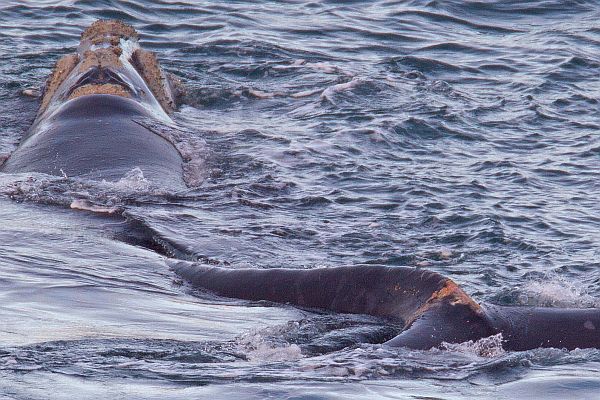
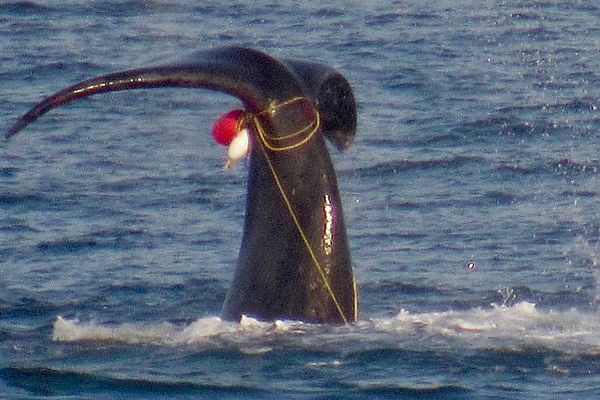
Deakin University volunteer Southern Right Whale program 2018
Volunteers from Deakin University, Warrnambool co-ordinated whale watching activities at Logan’s Beach in 2018. Speakers Jess Coxon and Madi O’Brien talk about the program to an audience at Warrnambool’s ‘Small things festival’.
Thank you to contributors
Mandy Watson acknowledges the efforts from all whale watch volunteers and data contributors who provided information to support the Southern Right Whale research program this year.
Weekly sightings 2018
Confirmed reports from Department of Environment, Water, Land and Planning (DEWLP), Mandy Watson, Senior Biodiversity Officer, Warrnambool.
Confirmed whale sightings to 15 June 2018
- 4 May Portland 1 x Blue Whale
- 19 May Portland 1 x SRW
- 20 May Portland 1 x SRW
- 24 May Portland 1 x SRW
- 28 May Phillip Island 1 x SRW
- 29 May Phillip Island 1 x SRW
- 1 June Logans Beach 4 x HBW
- 2 June Port Fairy 2 x HBW
- 3 June Logans Beach 3 x HBW
- 6 June Portland 1 x SRW
- 6 June Portland 1 x HBW
- 6 June Port Phillip Bay 2 x HBW
- 7 June Peterborough 1 x SRW adult
- 7 June Phillip Island 2 x SRW
- 8 June Logans Beach 1 x HBW
- 8 June Anglesea 2 x SRW
- 8 June Portland 1 x SRW
- 9 June Logans Beach 2 x HBW
- 9 June Portland 2 x SRW (1 sub adult)
- 10 June Phillip Island 1 x SRW
- 11 June Warrnambool 8 x HBW
- 11 June Portsea 2 X SRW
Confirmed whale sightings received by DELWP to 22 June 2018
- 16 June Portland 1 x SRW
- 18 June Portland 2 x SRW
- 19 June Logans Beach 1 x SRW
- 20 June Cape Nelson 2 x HBW
- 21 June Logans Beach 2 x SRW
- 21 June Logans Beach 3 x HBW
- 21 June Port Fairy 2 x SRW
- 22 June Portland 2 x HBW
- 22 June Logans Beach 1 x SRW
- 22 June Cape Nelson 1 x Humpback Whale
Photographs taken by a recently trained citizen scientist have enabled the identification of a whale seen at Logans Beach on 19th, 21st & 22nd June 2018 to be one of the regular breeding females. This whale, named 'Odd Lips' for her uneven lip callosities (seen in the image below taken on 13 Aug 2009). This female was first photographed with a calf in 2009 and again in 2014. She is expected to calve again in the coming days and remain in the region for the next 3 - 4 months.

Confirmed whale sightings to 29 June 2018
The first Southern Right Whale calf of the season was confirmed at Portland after receiving some wonderful photos from local photographers.
- 28 June Logans Beach 1 x Southern Right Whale
- 28 June Portland 3 x Southern Right Whale
- 28 June Portland 2 x Southern Right Whale
- 28 June Portland 2 x Humpback Whale
- 27 June Logans Beach 1 x Southern Right Whale
- 27 June Portland 2 x Southern Right Whale
- 26 June Portland 4 x Southern Right Whale
- 26 June Portland 2 x Southern Right Whale (Cow Calf pair)
- 26 June Portland 2 x Southern Right Whale
- 25 June Portland 2 x Southern Right Whale (Cow-Calf pair)
- 25 June Logans Beach 3 x Southern Right Whale
- 24 June Warrnambool 1 x Humpback Whale
- 24 June Port Fairy 1 x Southern Right Whale
- 24 June Portland 2 x Southern Right Whale (Cow-Calf pair)
- 24 June Portland 1 x Southern Right Whale
- 24 June Portland 2 x Southern Right Whale
- 23 June Portland 2 x Southern Right Whale
- 23 June Portland 2 x Humpback Whale
Confirmed whale sightings to 6 July 2018
30 June Portland 2 x Southern Right Whale (Cow - Calf pair)
1 July Portland 3 x Southern Right Whale
1 July Portland 3 x Southern Right Whale
2 July Logans Beach 1 x Southern Right Whale
2 July Phillip Island 1 x Southern Right Whale
3 July Portland 3 x Southern Right Whale
3 July Bridgewater 2 x Southern Right Whale
3 July Phillip Island 1 x Southern Right Whale
Confirmed whale sightings to 13 July 2018
The breeding female known as 'Odd Lips' has been seen around the South-west coast for weeks has finally been spotted at Logans Beach with a calf. This is the first recorded calf at Logans Beach this season.
It’s also been a wonderful week for whale watchers in Portland, with a very active Southern Right Whale mother and calf spotted every day!.
- 8 July Portland 2 x Southern Right Whale (Cow - Calf pair)
- 9 July Portland 2 x Southern Right Whale (Cow - Calf pair)
- 10 July Portland 1 x Humpback Whale
- 10 July Portland 2 x Southern Right Whale (Cow - Calf pair)
- 11 July Portland 2 x Southern Right Whale (Cow - Calf pair)
- 11 July Port Fairy 2 x Southern Right Whale
- 11 July Logans Beach 2 x Southern Right Whale (Cow - Calf pair)
- 12 July Portland 1 x Southern Right Whale
- 12 July Portland 1 x Humpback Whale
- 12 July Portland 2 x Southern Right Whale (Cow – Calf pair) 13 July Portland 5 x Humpback Whale
- 13 July Cape Bridgewater 2 x Humpback Whale
- 13 July Port Fairy 1 x Southern Right Whale
- 13 July Cape Bridgewater 2 x Humpback Whale
- 13 July Warrnambool 1 x Humpback Whale
Confirmed whale sightings to 20 July 2018
- 14 July Torquay 1 x Humpback Whale
- 14 July Portland 2 x Southern Right Whale
- 14 July Warrnambool 2 x Southern Right Whale (cow - calf pair)
- 14 July Logans Beach 2 x Southern Right Whale (cow - calf pair)
- 14 July Portland 2 x Southern Right Whale (cow - calf pair)
- 14 July Portland 3 x Southern Right Whale
- 15 July Portland 1 x Southern Right Whale
- 15 July Portland 2 x Southern Right Whale (cow - calf pair)
- 15 July Warrnambool 2 x Southern Right Whale (cow - calf pair)
- 15 July Logans Beach 2 x Southern Right Whale (cow - calf pair)
- 15 July Yambuk 2 x Southern Right Whale (cow - calf pair)
- 15 July San Remo 3 x Southern Right Whale
- 16 July Port Fairy 2 x Southern Right Whale
- 17 July Cape Nelson 3 x Southern Right Whale
- 17 July Portland 2 x Southern Right Whale (cow - calf pair)
- 19 July Portland 2 x Southern Right Whale
Confirmed whale sightings to 27 July 2018
There was also a thrill for whale watchers on Phillip Island with a pod of Killer Whales sighted multiple times on 20 July.
- 21 July Phillip Island 1 x Humpback Whale
- 21 July Warrnambool 2 x Southern Right Whale (cow - calf pair)
- 21 July Logans Beach 2 x Southern Right Whale (cow - calf pair)
- 22 July Phillip Island 2 x Humpback Whale
- 22 July Tyrendarra 7 x Southern Right Whale (2 x cow – calf pairs, 3 additional adults)
- 23 July Logan’s Beach 2 x Humpback Whale
- 23 July Portland 1 x Humpback Whale
- 23 July Phillip Island pod of Killer Whales
- 24 July Ocean Grove 2 x Southern Right Whale
- 24 July Lakes Entrance 2 x Southern Right Whale (cow - calf pair)
- 24 July Logans Beach 2 x Southern Right Whale (cow - calf pair)
- 25 July Cape Bridgewater 4 x Southern Right Whale
- 25 July Logans Beach 2 x Southern Right Whale (cow - calf pair)
- 26 July Torquay 1 x Southern Right Whale
- 26 July Bridgewater 2 x Southern Right Whale
- 26 July Tyrendarra 2 x Southern Right Whale
- 26 July Narrawong 3 x Southern Right Whale (cow - calf pair, 1 additional adult)
- 26 July Logans Beach 2 x Southern Right Whale (cow - calf pair)
- 26 July Narrawong 2 x Southern Right Whale (cow - calf pair)
- 26 July Bridgewater 1 x Southern Right Whale (grey morph)
- 27 July Cape Nelson 2 x Southern Right Whale
- 27 July Logans Beach 2 x Southern Right Whale (cow - calf pair)
- 27 July Cape Schank 1 x Southern Right Whale
- 27 July Portland 2 x Southern Right Whale
- 27 July Phillip Island 1 x Humpback Whale
Confirmed whale sightings to 3 August 2018
- 28 July Bridgewater Bay 2 x Southern Right Whale
- 28 July Cape Nelson 4 x Humpback Whale
- 28 July Surrey River 2 x Southern Right Whale (cow - calf pair)
- 28 July Warrnambool 2 x Southern Right Whale (cow - calf pair)
- 28 July San Remo 1 x Southern Right Whale
- 28 July Phillip Island 1 x Humpback Whale
- 28 July Narrawong 2 x Southern Right Whale (cow – calf pair)
- 29 July Phillip Island 2 x Southern Right Whale
- 31 July Portland 2 x Southern Right Whale
- 1 August Portland 3 x Southern Right Whale
- 1 August Portland 2 x Southern Right Whale (cow – calf pair)
- 2 August Cape Nelson 3 x Southern Right Whale
- 2 August Logans Beach 2 x Southern Right Whale
- 2 August Tyrendarra 3 x Southern Right Whale
- 2 August Nelson Bay 3 x Southern Right Whale
- 2 August Nelson Bay 1 x Humpback Whale
- 2 August Lakes Entrance 1 x Southern Right Whale
- 2 August Portland 2 x Southern Right Whale (cow - calf pair)
- 2 August Cape Nelson 3 x Southern Right Whale
- 2 August Logans Beach 2 x Southern Right Whale (cow - calf pair)
- 3 August Logans Beach 2 x Southern Right Whale (cow - calf pair)
- 3 August Nelson Bay 8 x Southern Right Whale
Confirmed whale sightings to 10 August 2018
- 4 August Portland 2 x Southern Right Whale
- 4 August Portland 7 x Southern Right Whale
- 5 August Portland 2 x Southern Right Whale
- 5 August Grant Bay Portland 1 x Southern Right Whale
- 5 August Logans Beach 2 x Southern Right Whale
- 5 August Lake Tyers 3 x Southern Right Whale (cow – calf pair, 1 additional adult)
- 6 August Portland 2 x Southern Right Whale
- 6 August Bridgewater Bay 3 x Southern Right Whale
- 6 August Narrawong 6 x Southern Right Whale (cow – calf pair, 4 additional adults)
- 7 August Portland 3 x Southern Right Whale
- 7 August Narrawong 4 x Southern Right Whale
- 8 August Portland 2 x Southern Right Whale
- 8 August Cape Grant 3 x Southern Right Whale
- 8 August Logans Beach 2 x Southern Right Whale (cow – calf pair)
- 9 August Bridgewater 2 x Southern Right Whale
- 9 August Portland 4 x Southern Right Whale
- 9 August Logans Beach 2 x Southern Right Whale (cow- calf pair)
- 9 August Logans Beach 2 x Southern Right Whale (cow – calf pair)
- 9 August Bridgewater Bay 5 x Southern Right Whale
- 10 August Logans Beach 2 x Southern Right Whale (cow – calf pair)
- 10 August Bridgewater Bay 3 x Southern Right Whale
- 10 August Bridgewater Bay 5 x Southern Right Whale
- 10 August Surrey River Mouth 2 x Southern Right Whale (cow - calf pair)
- 10 August Fitzroy River Mouth 2 x Southern Right Whale (cow - calf pair)
- 10 August Fitzroy River Mouth 2 x Southern Right Whale (cow - calf pair)
- 10 August Fitzroy River Mouth 2 x Southern Right Whale (cow - calf pair)
- 10 August Portland 3 x Southern Right Whale
- 10 August Portland 1 x Southern Right Whale
Confirmed whale sightings to 24 August 2018
DELWP successfully disentangled a Southern Right Whale at Portland on the 12th August. During the search for the entangled whale, flights allowed DELWP staff to sight numerous Southern Right Whales around the Portland area between the 9th and the 12th of August, including four cow-calf pairs.
- 11 August Portland 5 x Southern Right Whale (Entangled Southern Right Whale ‘Tangles’ and 4 additional adults)
- 11 August Port Phillip Bay 2 x Southern Right Whale
- 11 August Logans Beach 2 x Southern Right Whale (cow – calf pair)
- 12 August Logans Beach 2 x Southern Right Whale (cow – calf pair)
- 12 August Surrey River Mouth 2 x Southern Right Whale (cow – calf pair)
- 12 August Fitzroy River Mouth 2 x Southern Right Whale (cow – calf pair)
- 12 August Fitzroy River Mouth 2 x Southern Right Whale (cow – calf pair)
- 12 August Fitzroy River Mouth 1 x Southern Right Whale
- 12 August Cape Bridgewater 2 x Southern Right Whale
- 13 August Logans Beach 2 x Southern Right Whale (cow – calf pair)
- 14 August Logans Beach 2 x Southern Right Whale (cow – calf pair)
- 15 August Logans Beach 2 x Southern Right Whale (cow – calf pair)
- 16 August Logans Beach 3 x Southern Right Whale (cow – calf pair, 1 additional adult)
- 16 August Narrawong 2 x Southern Right Whale (cow – calf pair)
- 17 August Narrawong 2 x Southern Right Whale (cow – calf pair)
- 17 August Tyrendarra 2 x Southern Right Whale
- 20 August Narrawong 3 x Southern Right Whale
- 21 August Portland 1 x Southern Right Whale
- 21 August Narrawong 2 x Southern Right Whale (cow – calf pair)
- 22 August Narrawong 6 x Southern Right Whale (3 x cow – calf pairs)
- 22 August Tyrendarra 3 x Southern Right Whale
- 22 August Logans Beach 3 x Southern Right Whale (cow – calf pair, 1 additional adult)
- 22 August Portland 2 x Southern Right Whale
- 23 August Narrawong 10 x Southern Right Whale (3 x cow – calf pairs, 4 additional adults)
- 23 August Cape Nelson 3 x Southern Right Whale
- 23 August Logans Beach 2 x Southern Right Whale (cow – calf pair)
Confirmed whale sightings to 7 September 2018
- 25 August Narrawong 4 x Southern Right Whale
- 26 August Logans Beach 2 x Southern Right Whale (cow – calf pair)
- 27 August Logans Beach 2 x Southern Right Whale (cow – calf pair)
- 28 August Cape Nelson 2 x Southern Right Whale
- 29 August Logans Beach 2 x Southern Right Whale (cow – calf pair)
- 29 August Portland 1 x Southern Right Whale
- 29 August Waratah Bay 2 x Southern Right Whale (cow – calf pair)
- 30 August Tyrendarra 6 x Southern Right Whale
- 31 August Portland 9 x Southern Right Whale (3 x cow – calf pair, 3 additional adults)
- 31 August Logans Beach 2 x Southern Right Whale (cow – calf pair)
- 1 September Logans Beach 2 x Southern Right Whale (cow – calf pair)
- 1 September Portland 2 x Southern Right Whale
- 1 September Portland 6 x Southern Right Whale (2 x cow – calf pair, 2 additional adults)
- 2 September Portland 5 x Southern Right Whale
- 2 September Logans Beach 2 x Southern Right Whale (cow – calf pair)
- 3 September Portland 1 x Southern Right Whale
- 3 September Portland 4 x Southern Right Whale (cow – calf pair, 2 additional adults)
- 3 September Logans Beach 2 x Southern Right Whale (cow – calf pair)
- 3 September Marengo 1 x Southern Right Whale
- 4 September Cape Nelson 2 x Southern Right Whale
- 4 September Allestree 1 x Southern Right Whale
- 4 September Fitzroy River Mouth 2 x Southern Right Whale (cow – calf pair)
- 4 September Yambuk 4 x Southern Right Whale (2 x cow – calf pair)
- 4 September Yellow Rock 2 x Southern Right Whale
- 4 September Logans Beach 2 x Southern Right Whale (cow – calf pair)
- 5 September Logans Beach 2 x Southern Right Whale (cow – calf pair)
- 5 September Logans Beach 2 x Humpback Whale pods
- 5 September Bridgewater 2 x Southern Right Whale
- 5 September Killarney 3 x Southern Right Whale
- 5 September Portland 3 x Southern Right Whale
- 6 September Bridgewater 2 x Southern Right Whale
- 6 September Bridgewater 5 x Southern Right Whale
- 6 September Logans Beach 2 x Southern Right Whale (cow – calf pair)
- 7 September Logans Beach 2 x SRW (cow:calf pair)
Confirmed whale sightings to 21 September 2018
Unfortunately DELWP spent most of the week ending 14 September searching for an entangled whale which was seen near Apollo Bay on the evening of Monday 10th. Despite extensive air searches along the entire Victorian coast over 4 days, the whale has not been re-located. DELWP have notified colleagues interstate and hope that the whale will be sighted again somewhere before it departs on it's southward migration. If you see an entangled whale or any whale that appears to have rope markings on it's body please call the Whale and Dolphin Emergency Hotline on 1300 136 017.
- 8 September Logans Beach 2 x SRW (cow:calf pair)
- 9 September Logans Beach 2 x SRW (cow:calf pair)
- 10 September Logans Beach 2 x SRW (cow:calf pair)
- 10 September Apollo Bay 1 x SRW adult (entangled)
- 11 September Logans Beach 2 x SRW (cow:calf pair)
- 11 September Peterborough 2 x SRW (adults)
- 12 September Logans Beach 2 x SRW (cow:calf pair)
- 12 September Narrawong 6 x SRW (3 x cow:calf pairs)
- 13 September Logans Beach 2 x SRW (cow:calf pair)
- 13 September Skene's Creek 1 x SRW (adult)
- 13 September Narrawong 6 x SRW (3 x cow:calf pairs)
- 14 September Logans Beach 2 x SRW (cow:calf pair)
- 14 September Cape Grant 3 x SRW
- 14 September Lake Tyers 2 x SRW (1 x cow:calf pair)
- 15 September Bridgewater Bay 3 x SRW
- 17 September Portland 2 x SRW (1 x cow:calf pair)
- 18 September Narrawong 2 x SRW (1 x cow:calf pair)
- 21 September Portland 2 x SRW (1 x cow:calf pair)
2019 Whale sightings
Confirmed reports from Department of Environment, Water, Land and Planning (DEWLP), Mandy Watson, Senior Biodiversity Officer, Warrnambool.
One of the regular breeding females from Logans Beach known as Tripod, was observed and photographed at Logans Beach between 29 May and 2 June. She appeared to be heavily pregnant, so we are expecting her to return with a calf any day. Female Southern Right Whales have a strong site fidelity for nursery grounds, generally returning to the same locations every 3 years to calve and nurse their young. Tripod was last recorded at Logans Beach with a calf in 2015. It is not known why Tripod failed to calve here in 2018, but it may be that she lost a pregnancy or did not conceive in 2017.
Results from the 2019 photo-ID matching for the South East Australian Photo Identification Catalogue (SEA SRW PIC) project.
37 different southern right whales were identified (comprising of 8 cow:calf pairs and 29 unaccompanied adults) from images contributed by around 20 citizen scientist from across Victoria and New South Wales. Six of the 32 whales were re-sights (already in the SEA SRW PIC) and 26 were new to the catalogue.
5 May to 19 June 2019
- 5 May Portland 1 x SRW
- 6 May Cape Bridgewater 1 x SRW
- 22 May Cape Schanck 1 x HBW
- 29 May Logans Beach 1 x SRW (Tripod)
- 30 May Logans Beach 1 x SRW (Tripod)
- 31 May Logans Beach 1 x SRW (Tripod)
- 1 June Logans Beach 1 x SRW (Tripod)
- 1 June Logans Beach 3 x HBW
- 2 June Logans Beach 1 x SRW (Tripod)
- 8 June Cape Schanck 1 x HBW
- 9 June Port Fairy 1 x SRW
- 15 June Portland 2 x SRW
- 19 June Logans Beach 1 x SRW
21 June to 4 July 2019
- 21 June Port Fairy 2 x SRW (cow: calf pair)
- 23 June Phillip Island 1 x SRW
- 23 June Portland 8 x HBW
- 23 June Portland 1 x SRW
- 23 June Port Fairy 2 x SRW (cow: calf pair)
- 23 June Port Campbell 2 x SRW
- 23 June Cape Liptrap 1 x HBW
- 25 June Logans Beach 2 x SRW (cow (Tripod): calf pair)
- 26 June Logans Beach 2 x SRW (cow (Tripod): calf pair)
- 26 June Port Fairy 1 x SRW
- 26 June Port Fairy 2 x SRW
- 26 June Port Fairy 3 x SRW
- 26 June Johanna Beach 2 x SRW
- 26 June Port Fairy 2 x SRW
- 27 June Portland 1 x SRW
- 28 June Barwon Heads 2 x SRW
- 28 June Barwon Heads 2 x HBW
- 28 June Portland 2 x SRW
- 28 June Logans Beach 2 x SRW (cow (Tripod): calf pair)
- 2 July Phillip Island 1 x SRW
- 3 July Phillip Island 2 x SRW
4 July to 19 July 2019
- 4 July Phillip Island 1 x SRW
- 4 July Phillip Island 2 x SRW
- 4 July Portland 1 x SRW
- 8 July Logans Beach 1 x SRW (Big Coaming)
- 9 July Logans Beach 1 x SRW
- 10 July Logans Beach 1 x SRW
- 11 July Logans Beach 1 x SRW
- 12 July Logans Beach 1 x SRW
- 12 July Mallacoota 1 x SRW
- 13 July Logans Beach 1 x SRW
- 15 July Logans Beach 1 x SRW
- 16 July Port Fairy 2 x SRW
- 16 July Cape Nelson 1 x SRW
- 16 July Logans Beach 1 x SRW
- 17 July Logans Beach 1 x SRW
- 17 July Port Phillip Bay 2 x SRW
- 18 July Logans Beach 1 x SRW
19 July to 28 July 2019
- 19 July Portland 3 x SRW
- 19 July Cape Schanck 1 x SRW
- 19 July Cape Schanck 1 x HBW
- 19 July Portland 2 x SRW
- 20 July Logans Beach 1 x SRW
- 20 July Logans Beach 2 x HBW
- 21 July Point Lonsdale 2 x HBW
- 21 July Portland 3 x SRW
- 22 July Logans Beach 2 x SRW (cow (Big Coaming): calf pair)
- 23 July Logans Beach 2 x SRW (cow (Big Coaming): calf pair)
- 23 July Cape Nelson 8 x HBW
- 25 July Logans Beach 2 x SRW (cow (Big Coaming): calf pair)
- 25 July Logans Beach 2 x HBW
- 25 July Portland 2 x SRW
- 26 July Logans Beach 2 x SRW (cow (Big Coaming): calf pair)
- 27 July Logans Beach 2 x SRW (cow (Big Coaming): calf pair)
- 28 July Logans Beach 2 x SRW (cow (Big Coaming): calf pair)
- 28 July Cape Conran 2 x SRW
29 July to 8 August 2019
- 28 July Queenscliff 1 x SRW
- 29 July Logans Beach 2 x SRW (cow (Big Coaming): calf pair)
- 30 July Portland 2 x SRW
- 30 July Logans Beach 2 x SRW (cow (Big Coaming): calf pair)
- 30 July Lorne 4 x SRW
- 30 July Marengo 1 x SRW
- 31 July Logans Beach 2 x SRW (cow (Big Coaming): calf pair)
- 31 July Logans Beach 1 x SRW
- 31 July Portland 2 x SRW
- 1 August Logans Beach 2 x SRW (cow (Big Coaming): calf pair)
- 1 August Logans Beach 3 x HBW
- 1 August Portland 1 x SRW
- 2 August Logans Beach 2 x SRW (cow (Big Coaming): calf pair)
- 2 August Logans Beach 1 x SRW
- 3 August Port Fairy 2 x SRW (cow: calf pair)
- 3 August Logans Beach 1 x SRW (Tripod)
- 3 August Portland 2 x SRW
- 4 August Portland 2 x SRW (cow: calf pair)
- 4 August Logans Beach 2 x SRW (Tripod plus single adult)
- 5 August Logans Beach 3 x SRW (cow (Big Coaming): calf pair and Tripod)
- 5 August Warrnambool 1 x HBW
- 6 August Portland 2 x SRW (cow: calf pair)
- 6 August Logans Beach 3 x SRW (cow (Big Coaming): calf pair and Tripod)
- 7 August Portland 2 x HBW
- 7 August Point Richie 2 x SRW (cow (Big Coaming): calf pair)
- 7 August Logans Beach 1 x SRW (Tripod)
8 August to 22 August
- 8 August Cape Nelson 1 x HBW
- 8 August Logans Beach 3 x SRW (cow (Big Coaming): calf pair, and Tripod)
- 9 August Logans Beach 3 x SRW (cow (Big Coaming): calf pair, and Tripod)
- 10 August Logans Beach 4 x SRW (cow (Black Bonnet): calf pair and cow (Big Coaming): calf pair)
- 11 August Portland 3 x SRW
- 12 August Logans Beach 4 x SRW (cow (Black Bonnet): calf pair and cow (Big Coaming): calf pair)
- 13 August Logans Beach 2 x SRW (cow (Big Coaming): calf pair)
- 14 August Logans Beach 2 x SRW (cow (Big Coaming): calf pair)
- 14 August Portland 2 x SRW (cow (Continuous Coaming): calf pair)
- 14 August Portland 2 x SRW (harassed by Killer Whale)
- 14 August Portland 1 x KW
- 14 August Logans Beach 2 x SRW (cow (Big Coaming): calf pair)
- 15 August Port Campbell 2 x SRW
- 16 August Logans Beach 3 x SRW (cow (Big Coaming): calf pair and single adult)
- 17 August Logans Beach 2 x SRW
- 17 August Logans Beach 2 x SRW (cow (Big Coaming): calf pair)
- 18 August Portland 1 x SRW
- 18 August Logans Beach 2 x SRW (cow (Big Coaming): calf pair)
- 21 August Logans Beach 2 x SRW (cow (Big Coaming): calf pair)
- 22 August Logans Beach 2 x SRW (cow (Big Coaming): calf pair)
23 August to 20 September
- 6 September Bridgewater Bay 2 x SRW
- 6 September Logans Beach 3 x SRW (cow: calf pair) and Big Coaming
- 7 September Logans Beach 1 x SRW (Big Coaming)
- 7 September Cape Nelson 1 x HBW
- 8 September Cape Nelson 1 x HBW
- 11 September Logans Beach 1 x SRW (Big Coaming)
- 12 September Cape Nelson 1 x HBW
- 13 September Logans Beach 1 x SRW
- 14 September Cape Nelson 1 x unidentified entangled whale
- 14 September Cape Nelson multiple HBW
- 15 September Portland 1 x HBW
SRW = Southern Right Whale
HBW= Humpback Whale
KW= Killer Whale
2020 Whale sightings
Confirmed reports from Department of Environment, Water, Land and Planning (DEWLP), Mandy Watson, Senior Biodiversity Officer, Warrnambool.
It’s been a very quiet season for Southern Right Whales in Victoria this year. There have been no resident females with calves at Logans Beach. This is a surprise given that 2017 was a big year for calving and it was expected that a number of the regular breeding females including ‘Big Lips, and ‘Long Coaming’ would arrive this year. The non-arrival of this cohort of females suggests that they may have extended their 3-year calving cycle.
Results from the 2020 photo-ID matching for the South East Australian Photo Identification Catalogue (SEA SRW PIC) project.
21 different southern right whales were identified : 5 x cow:calf pairs, including 4 new females and 1 re-sight.
16 unaccompanied adults were detected and catalogued, all being new to the Catalogue.
Three different cow:calf pairs were sighted in NSW this season.
A rare sighting of a Minke Whale was reported at Cape Conran on 30 August.
- 11 June x SRW Phillip Island
- 16 June x 2 SRW Portland
- 5 July x 1 SRW (grey morph) Protland
- 28 June x1 SRW (CC pair) Cape Schanck
- 8 July x 1 SRW (CC pair) same pair as above Portland then 16 July Encounter Bay South Australia
- 18 June x 1 SRW Seaspray/Loch Sport, (also 2 July and 8 July)
- 19 June x 1 SRW Skene’s Creek
- 10 July x 1 SRW Logan’s Beach
- 26 Jul 3 x SRW (adults) Phillip Island
- 29 Jul 3 x SRW (adults) Rye ocean beach
- 1 Aug 1 x SRW (adult) Peterborough
- 2 Aug 1 x SRW (adult) Phillip Island
- 2 Aug 2 x SRW (adults) Cape Nelson
- 2 Aug 2 x SRW (CC pair) Manly Beach NSW
- 3 Aug 1 x SRW (adult) Sealers Cove
- 3 Aug 1 x SRW (adult) Marengo
- 4 Aug 2 x SRW (CC pair) North Tura NSW
- 5 Aug 2 x SRW (adults) Portland
- 10 Aug 1 x SRW (adult) Koonya ocean beach (Mornington Peninsular)
- 11 Aug 2 x SRW (CC pair*) Ocean Grove
- 15 Aug 1 x SRW (adult) Portland
- 16 Aug 1 x SRW (adult) Portland
- 16 Aug 2 x SRW (CC pair) Wattamolla NSW
Note: Humpback Whale sightings are not included in the above list.
2021 Whale sightings
This report only contains a brief summary of the season. More details of the 2021 season, reports and findings are now found on WhaleFace.
The first sighting in Victoria was at Port Campbell 30th May 2021.
The first cow:calf sighting in Victoria for 2021 was at Portland 19 June 2021.
The last cow:calf sightings were 18 September near Portland and two cow:calf pairs in the Apollo Bay area on 29 September.
Up to 6 different cow:calf pairs were observed at one time across Victoria:
- Logans Beach/Warrnambool
- Yambuk-Portland
- Port Fairy
- Surf Coast: (Barwon Heads, Lorne, Port Campbell, Apollo Bay, Point Roadknight)
- Port Phillip Bay (Mornington/Mt Martha)
- Gippsland (Corner Inlet)
There were re-sightings of three familiar breeding females which returned to give birth in Victorian waters.
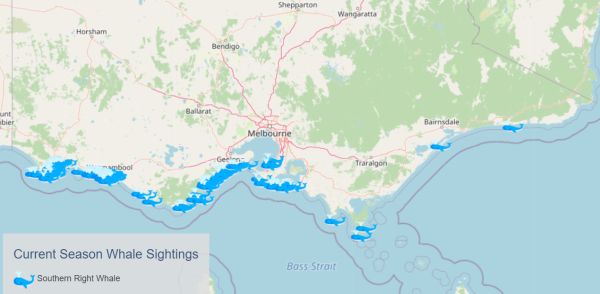
2022 Whale sightings
Highlights from WhaleFace news in 2022
The first Southern Right Whale sighting in Victoria for 2022 was 2 unaccompanied adults in the Portland area between Yambuk to Bridgewater on 9 May 2022.
The first confirmed Southern Right Whale cow and calf sighting was on 23 June 2022 west of Port Campbell. The same pair was observed at Port Campbell between 25-29 June.
The Southern Right Whale known as 'Big Lips' returned back to Logans Beach for her 8th calving season. Big Lips was first sighted with a calf in 1995, since then she has returned to have 8 calves.
Results from the 2022 photo-ID matching for the South East Australian Photo Identification Catalogue (SEA SRW PIC) project.
Individual Photo-id data was obtained for 30 Southern Right Whales including:
- 11 x cow with calves
- 6 x calves
- 13 x unaccompanied adults
This included re-sightings of four known breeding females:
- SE0202 Big Lips (with calf)
- SE1401 (with calf)
- SE1718 (with calf)
- SE0203 Bonnet (without a calf)
Two new females with calves have been recorded in south-western Victoria. They have been using coastal areas from Port Campbell to Port Fairy (including the Logans Beach nursery area).
A rare grey morph calf was observed travelling with its mother along the Victorian coast. The pair was identified as coming from southern NSW and travelling from east to west along the Victoria coastline in September 2022.
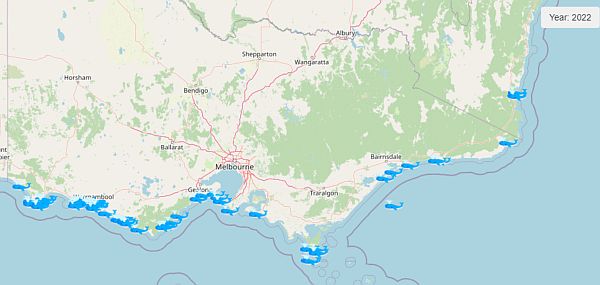
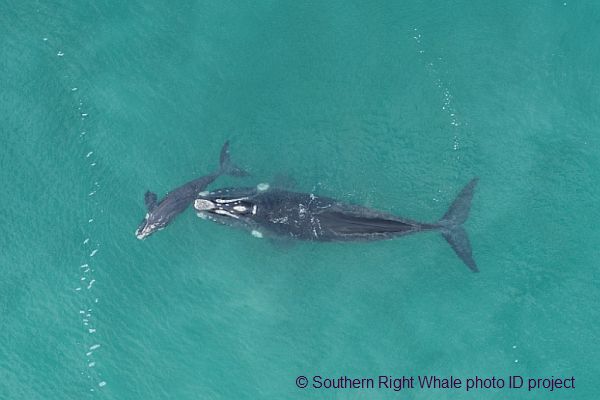
Cow-calf pair at Logans Beach on 9/8/22. Images taken under research permit (no. 10010359) under Section 78 (1) (c) of the Wildlife Act 1975 and Animal Ethics approval (AEC 22-001) Source: WhaleFace news August 2022.
2023 Whale sightings
The first sighting of a Southern Right Whale in Victoria was 27 May 2023 being 2 unaccompanied adults in the Portland area.
As of late August there has been only one report of a cow: calf pair along the Victorian coastline this season at Portland.
Sightings of unaccompanied adult SRW have been made at Logans Beach (Warrnambool), Killarney (Port Fairy) , Yambuk-Bridgewater (Portland), Surf Coast area, Cape Paterson area, Wilsons Promontory, offshore from Lakes Entrance and Mornington Peninsula ocean side.
Air surveys were conducted along the entire Victorian coastline on 20th and 21st of June) and 14th and 15th August with no whales being detected.
An interesting report of a SRW called ‘Tripod’ which was first identified in Victorian waters in June 1995 and has since made regular appearances at Logans Beach has been sighted again this season. Tripod has often given birth every two years, the last being in 2019. This season marks the 10th year Tripod has been seen on the Victorian coast.
Results from the 2023 photo-ID matching for the South East Australian Photo Identification Catalogue (SEA SRW PIC) project.
- 1 x cow with calf
- 11x unaccompanied Adult
This included resighting’s of two known breeding females - SE1224 (with calf) and Tripod SE0201(no calf) and one previously identified unaccompanied adult – SE1328.
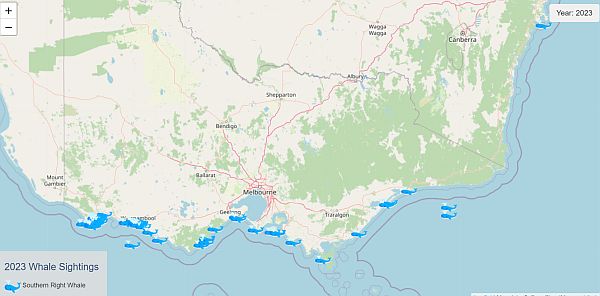
2024 Whale sightings
- The first sighting of the season was on the 26th May - a single adult at Cape Nelson.
- The first sighting of a cow-calf pair was on the 18th of June near Tyrendarra.
- The last sighting of a cow-calf pair was on the 21st of August at Port Fairy.
- The final Southern Right Whale sighting for the 2024 season (and the only sighting we had outside of south west Victoria) was on the 26th of August at Lake Tyers.
Sightings of unaccompanied adults were made at Cape Nelson, Portland, Port Fairy, Warrnambool, Nullawarre, Port Campbell, Lorne and Lake Tyers.
Cow-calf pairs were observed at Cape Nelson, Portland, Narrawong/Tyrendarra, Yambuk, Port Fairyand Warrnambool.
Information to-date suggests that at least eight cow-calf pairs were off the Victorian coast during the 2024 season.
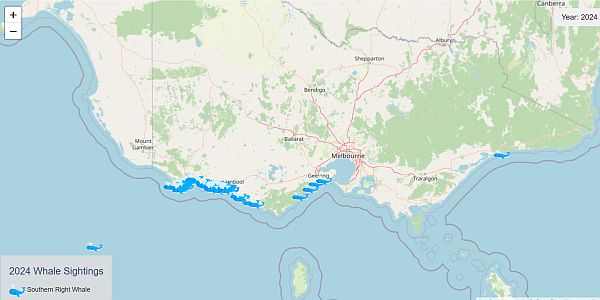
More detailed report on 2024 season, see; WhaleFace
2025 Whale sightings
The first sightings of a Southern Right Whale in Victoria occurred on 15 May 2025 off Warrnambool. On 21 May 2025 a pair of Sothern Right Whales was photographed near Portland Bay.
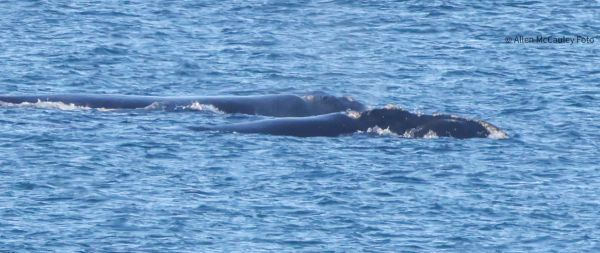
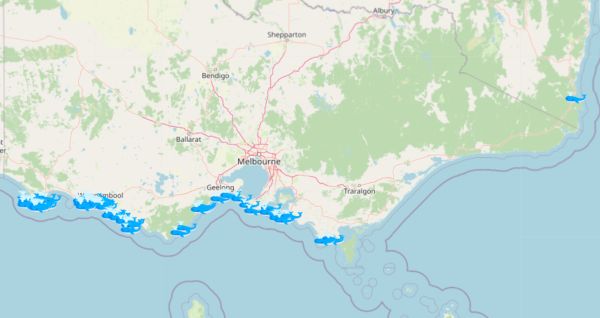
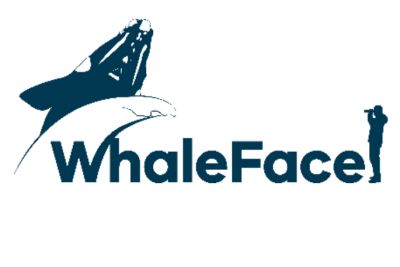
Contribute whale sightings and photos for the photo identification research project using the online WhaleFace (Whale Sightings Uploader).
You can also contribute sightings reports or images to the DEECA whale research program please email: southern.r.whales@delwp.vic.gov.au This data once validated will be added to the department's official fauna and flora database. If you would like your sighting to be recorded in the database please ensure you provide the following information;
- Photos
- Date
- Time
- Location (Preferably GPS coordinates)
- Description including, species (if known), number of whales, behaviour/direction of travel
- Preferred follow-up contact details (email or phone)
References
- Carroll, E., Patenaude, N., Alexander, A., Steel, D., Harcourt, R., Childerhouse, S., Smith, S., Bannister, J., Constantine, R., Scott Bake, C.,(2011) Population structure and individual movement of southern right whales around New Zealand and Australia Marine Ecology Progress Series Vol 432, pp 257-268.
Watson, M., Stamation, K. Charlton, C. and Bannister, J. (2021) Calving intervals, long-range movements and site fidelity of southern right whales (Eubalaena australis) in southeastern Australia. Journal of Ceatacean Research Management 22: 17-28
See also:
Southern Right Whale Species profile (Description, Conservation status, Distribution, Ecology, Threats and Management)


